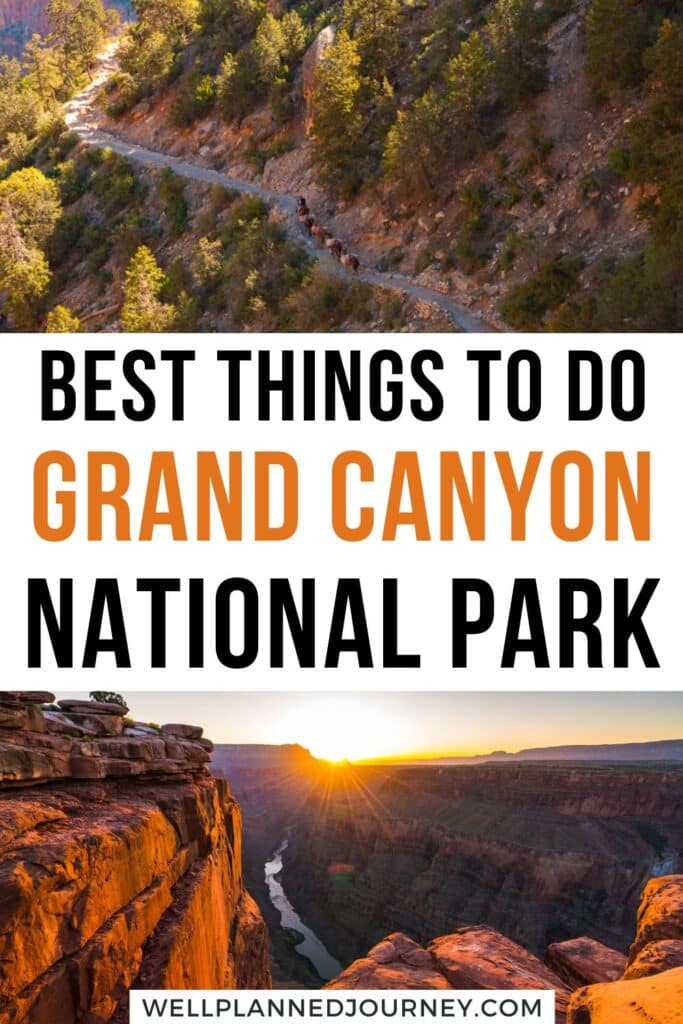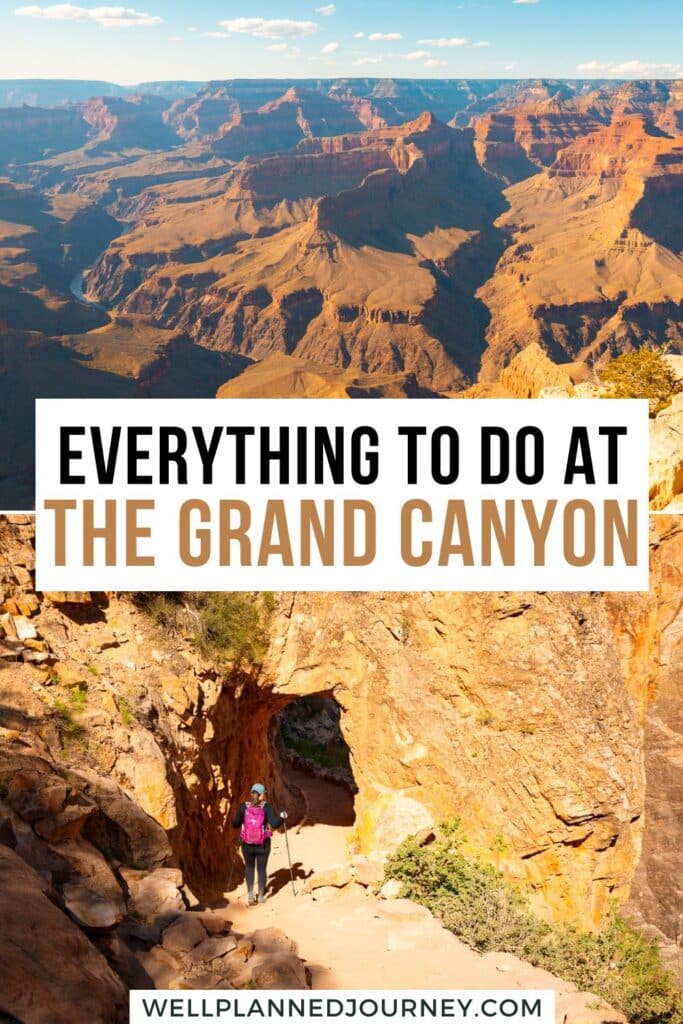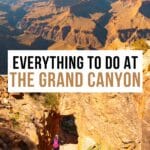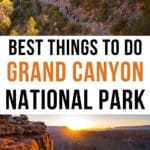Are you planning a trip to the South Rim of Grand Canyon National Park but need help figuring out where to start?
The Grand Canyon is one of the world’s seven natural wonders, with incredible views, day hikes, and activities for every itinerary. The South Rim, the most visited part of the Grand Canyon, covers miles of stunning landscapes.
But most visitors only have a few days to explore the Grand Canyon, so how do you prioritize your time in this famed national park?
This guide covers the best things to do in the Grand Canyon South Rim, tips on visiting the Grand Canyon for the first time, suggested itineraries, where to stay, and more!
This post may contain affiliate links, where I may receive a small commission at no additional cost to you. Read more in this disclosure policy.
Grand Canyon National Park At-A-Glance
Before diving in, here are a few highlights to help you plan your trip:
- Best Time to Visit: Spring or Fall are the best times to visit, thanks to the mild weather, perfect for hiking. Avoid crowds by visiting in April to mid-May or mid-September to October, on either end of peak season.
- Where to Stay: If you want to stay in the park, choose from the luxury El Tovar Hotel, historic Bright Angel Lodge, or the newly renovated Maswik Lodge. If you want to stay outside the park, I highly recommend The Grand Hotel or Best Western Squire Resort in Tusayan.
- How to Get There: The closest airports are Las Vegas (4 hours away) or Phoenix (3.5 hours away). Use Expedia to browse flights and find the best price.
- How to Get Around: Grand Canyon National Park offers free shuttles year-round at the South Rim, which saves time trying to find parking. However, you’ll still need your own car to get to the park. Use Expedia to browse deals on rental cars or rent an RV or campervan with Outdoorsy!
- Best Self-Guided Tour: My favorite way to learn more about the park is with GuideAlong, a narrated self-guided tour perfect for road trips and scenic drives. The Grand Canyon South Rim Guide provides incredible commentary and detail about the history and geology of this natural wonder.
- Don’t Forget: Be sure to get an America the Beautiful National Park Pass ahead of time. This $80 pass is valid for 12 months and gets you into all 400+ national park sites (including the Grand Canyon!).
What to Know Before Going to the Grand Canyon South Rim
Before diving into the top things to do, it’s essential to understand more about the various regions of the Grand Canyon and how the South Rim fits into the landscape. Plus, this section details how to get to the South Rim and how to get around using the shuttle system once you arrive.
Overview of the Regions of the Grand Canyon
The Grand Canyon spans more than 220 miles along the Colorado River, but only a portion of the famed canyon is protected by the National Park Service. Local or indigenous organizations, like the Hualapai Tribe, preserve the rest of the land.
Generally, the Grand Canyon can be broken up into three main sections:
- South Rim: This is the most visited area of the Grand Canyon and the focus of this blog post. The South Rim is home to popular hiking trails like Bright Angel Trail and Grand Canyon Village and stunning viewpoints like Mather Point. The South Rim also has several lodges, campgrounds, and restaurants and is open year-round. A free shuttle service helps visitors navigate the South Rim, connecting most of the activities listed in this guide. A 40-minute drive takes you to the southeastern part of the canyon (sometimes called the ‘East Rim’), which features the Desert View Watchtower.
- North Rim: Located 10 miles across the Grand Canyon from the South Rim, reaching the North Rim requires detouring nearly 4 hours out and around (unless you hike through the canyon!). This lesser-visited part of the Grand Canyon is only open in the summer.
- Grand Canyon West: The western rim of the Grand Canyon is part of the Hualapai Indian Tribal Lands, not the national park. Located about two hours from Las Vegas, this is the most popular part of the Grand Canyon for a day trip. Grand Canyon West features the Grand Canyon Skywalk, a glass bottom platform suspended 4,700 feet above the canyon floor.
For this post, we’re focused on the most visited South Rim.


How to Get to the South Rim of the Grand Canyon
The South Rim of the Grand Canyon is in northwestern Arizona, hours away from any major city. The easiest way to get to the Grand Canyon is by car or on a guided tour.
The closest airports to the Grand Canyon South Rim are:
- Flagstaff Pulliam Regional Airport (FLG): 90 miles, 1.5 hours
- Phoenix Sky Harbor International Airport (PHX): 230 miles, 3.5 hours
- Harry Reid International Airport in Las Vegas (LAS): 280 miles, 4.5 hours
I use Expedia to find the best flight prices and compare routes. Once you find your flight, you can book directly through Expedia to save money, but still enter your frequent flyer numbers to get points!
If you need a rental car, I also recommend using Expedia to find the best deals across brands like Avis, Hertz, Enterprise, Budget, and more.
Other nearby destinations include:
- Page, Arizona: 130 miles, 2.5 hours
- Monument Valley: 175 miles, 3 hours
- Grand Canyon North Rim: 210 miles, 4 hours
- Grand Canyon West Rim / SkyWalk: 240 miles, 4.5 hours
- Zion National Park: 250 miles, 5 hours
- Moab & Arches National Park: 325 miles, 5.5 hours
Are you interested in visiting the Grand Canyon on a tour instead? Consider some of these top-rated Grand Canyon tours out of Las Vegas!
Grand Canyon National Park Entrance Fees
When driving a personal vehicle into the park, you must stop at the Grand Canyon National Park entrance station to pay the entrance fee.
You have a couple of options to cover your entrance fee:
- Grand Canyon 7-Day Pass: This can be purchased upon arrival at the entrance station, is valid for seven days, and costs $35.
- America the Beautiful National Park Pass: This can be purchased in advance, is valid for 12 months and gets you into all 400+ national park sites. Plus, the South Entrance Station (the most popular route into the park) has a dedicated lane for pass holders that can help you breeze past the traffic! Get your national park pass in advance for only $80.
Parking at the Grand Canyon South Rim
The Grand Canyon South Rim receives more than 15,000 daily visitors during the busy season. Parking in Grand Canyon Village is challenging if you visit from late Spring to early Fall.
The best place to park at the Grand Canyon South Rim is in the large parking lots surrounding the Grand Canyon Visitor Center. The lots shown in the map below (lots 1-3, lot 4) provide excellent access to the free Grand Canyon shuttle that runs year-round.
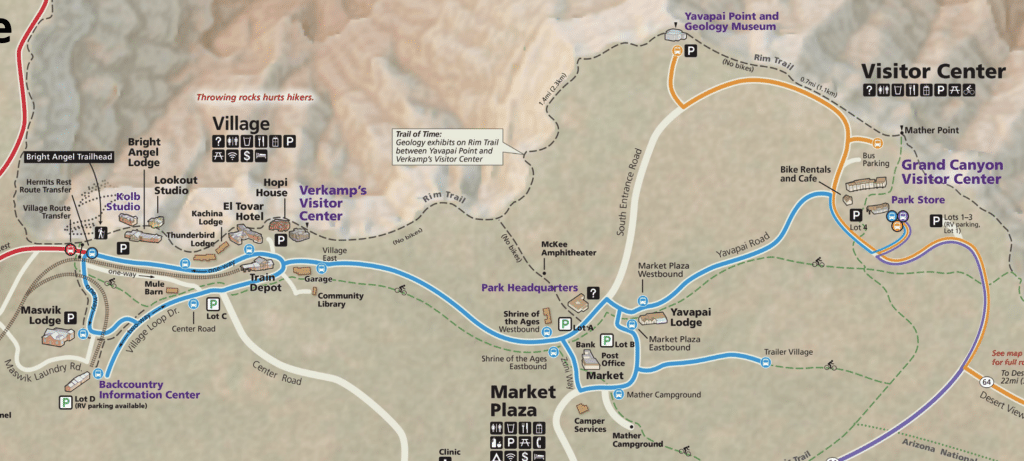
Parking further into Grand Canyon Village, particularly near El Tovar Hotel and Bright Angel Lodge, is nearly impossible at midday as parking lots are limited. Rather than parking at these viewpoints and lodges, plan to park at the visitor center and use the shuttle instead.
While parking at the visitor center is plentiful, lots can still fill up in the summer, so plan to arrive in the early morning or late afternoon to find a convenient parking spot and avoid circling the lot to snag a spot. In addition, arriving early at the park can help you avoid long lines at the South Rim entrance station into the park.
From March to November, Hermit’s Rest Road is closed to private vehicles, so all visitors must take the park shuttle instead of being able to park at the viewpoints.
You can read more about parking at the Grand Canyon South Rim here.
Taking the Shuttle at the Grand Canyon South Rim
Grand Canyon National Park has one of the most advanced national park shuttle systems – and it’s free! Rather than battling for parking at the South Rim, I highly recommend parking at the visitor’s center and taking the shuttle around the park. You’ll save yourself lots of hassle!
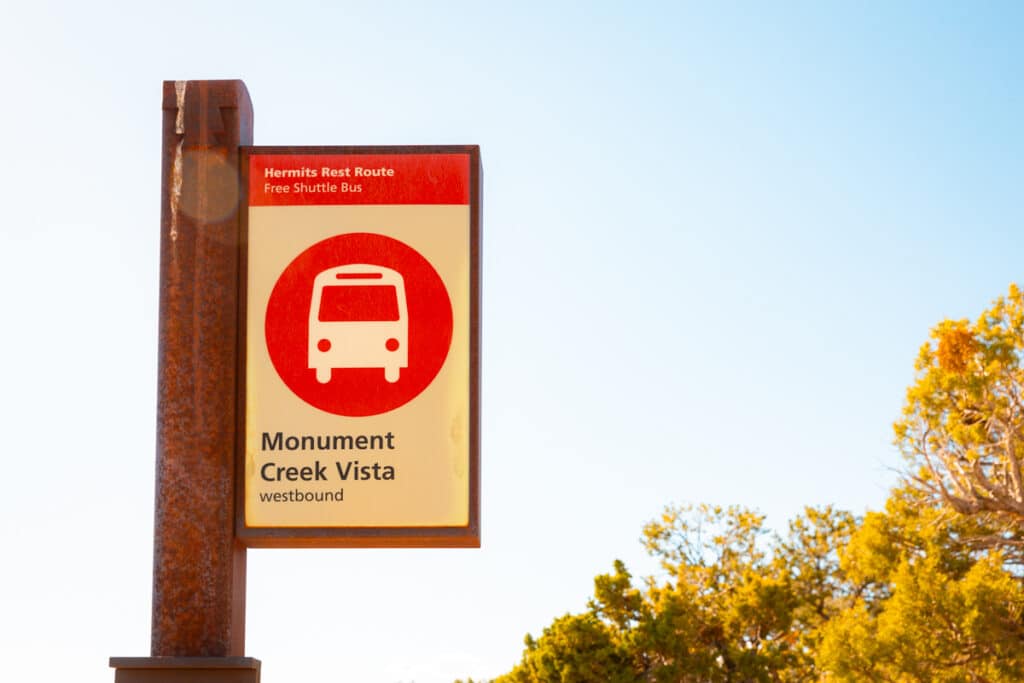
Several shuttle routes operate at the South Rim, each with varying operating seasons and destinations:
- Village (Blue) Route
- Operating Season: Year-Round
- Route: Loop around Grand Canyon Village and connecting the Grand Canyon Visitor Center and Hermits Rest Route Transfer stops
- Round-Trip Time: 50 minutes
- Key Points of Interest on Route: El Tovar Hotel, Bright Angel Hotel, Bright Angel Trail, Mather Campground
- Note: If you’re looking for an express route to the visitor center or the South Kaibab Trailhead without transferring, consider taking the Hikers’ Express Shuttle in the early morning.
- Kaibab Rim (Orange) Route
- Operating Season: Year-Round
- Route: Loop that connects the visitor center and the South Kaibab Trailhead, with several stops at viewpoints in between
- Round-Trip Time: 50 minutes
- Key Points of Interest on Route: South Kaibab Trail, Yaki Point, Mather Point, Yavapai Geology Museum
- Note: If you want an express route to South Kaibab Trailhead, consider taking the Hikers’ Express Shuttle in the early morning instead.
- Hermit Road (Red) Route
- Operating Season: March 1 to November 30
- Route: Out and back route that connects Grand Canyon Village and Hermits Rest, with stops at nine incredible viewpoints along the way
- Round-Trip Time: 80 minutes
- Key Points of Interest on Route: Powell Point, Hopi Point, Mohave Point, Pima Point, Hermits Rest
- Note: When the shuttle operates, this is the only way to navigate Hermit Road, as the roadway is closed to personal vehicles.
- Tusayan (Purple) Route
- Operating Season: May 27 to September 9
- Operating Hours: Every 20 minutes between 8 AM and 9:30 PM
- Route: Connects the town of Tusayan to the Grand Canyon Visitor Center, avoiding long lines at the South Entrance Station
- Round-Trip Time: 40 minutes
- Key Points of Interest on Route: IMAX Theater, Best Western Squire Inn, The Grand Hotel, Big E Steakhouse, Grand Canyon Visitor Center
- Note: Riding this route still requires a valid national park entrance pass (see above under the entrance fees section)
The three main shuttle routes (Village, Kaibab, and Hermit) run daily during the operating season from roughly one hour before sunrise to one hour after sunset. In the summer, that’s 4 AM to 10 PM. During the day, shuttles will come every 10-15 minutes. Expect to wait around 30 minutes between shuttles in the early morning or evening.
Are you planning a national park trip but don’t know where to start? Get my free 28-page national park ebook where I break down everything you need to know to visit all 63 USA national parks.
Download your free ebook here.
Best Things to Do in Grand Canyon South Rim
Grand Canyon National Park has excellent activities for every type of traveler, from hikers to casual road trippers. This section covers the 22 best things to do at the Grand Canyon South Rim: hikes, scenic drives, incredible viewpoints, and more!
1. Visit the South Rim Viewpoints
The Grand Canyon’s South Rim is filled with breathtaking viewpoints, each offering its unique embrace of the canyon’s depth, history, and ever-evolving colors.
If you have a few days in the park, you can easily see these viewpoints!
- Grand Canyon Village Viewpoints: Mather Point, Yavapai Point, Mary Colter’s Lookout Studio, Bright Angel Trailhead
- Hermits Rest Viewpoints: Trailview Overlook, Maricopa Point, Powell Point, Hopi Point, Mohave Point, The Abyss, Monument Creek Vista, Pima Point, Hermits Rest
- Desert View Drive Viewpoints: Desert View Watchtower, Navajo Point, Lipan Point, Moran Point, Grandview Point, Shoshone Point, Ooh Aah Point, Yaki Point
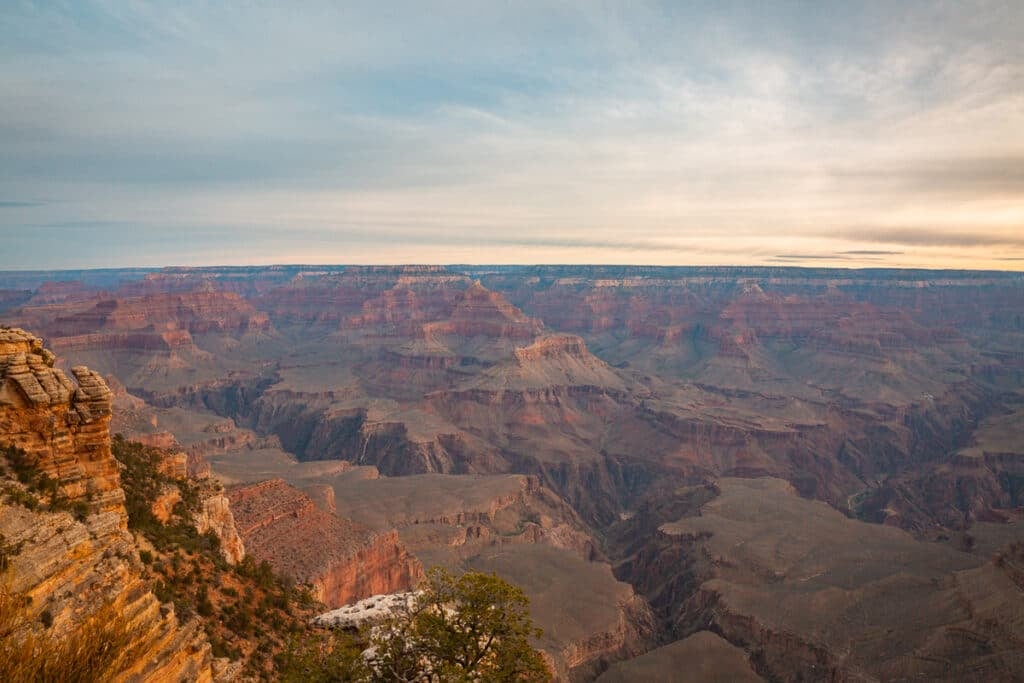
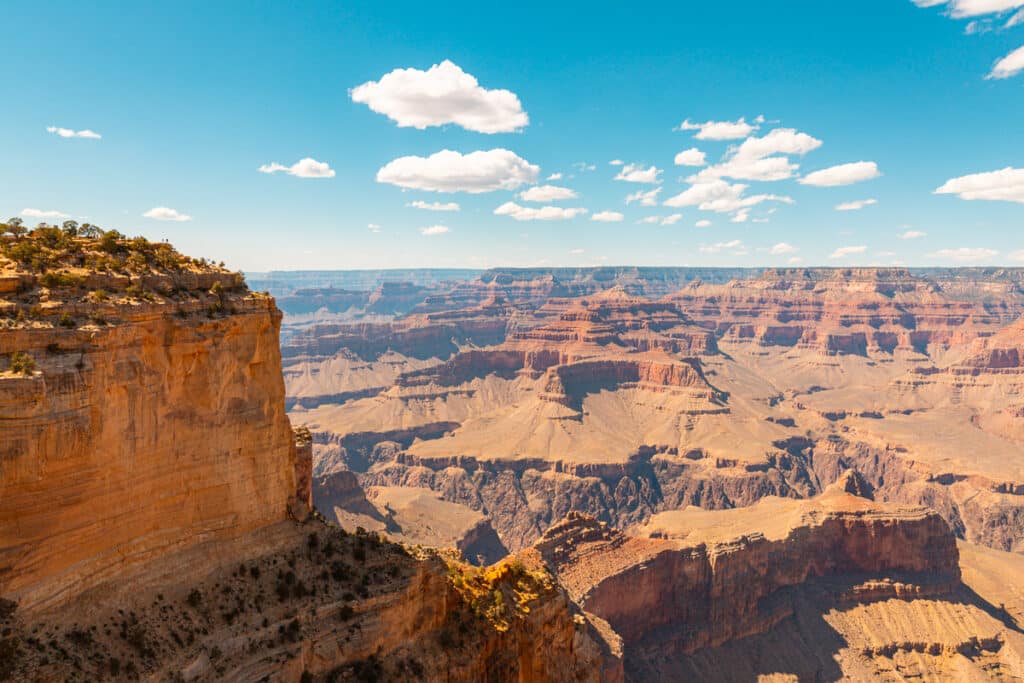

If you want more details on the best way to see these incredible viewpoints, check out this detailed post on the best Grand Canyon South Rim viewpoints.
2. Hike the Bright Angel Trail
As one of the most popular trails in the park, the Bright Angel Trail is a rite of passage for any Grand Canyon visitor. This once-in-a-lifetime hike gives visitors incredible close-up views of the intricate rock layers and geology of the Grand Canyon.
The trail starts along the Rim Trail in Grand Canyon Village, just past Bright Angel Lodge. From there, choose your adventure!
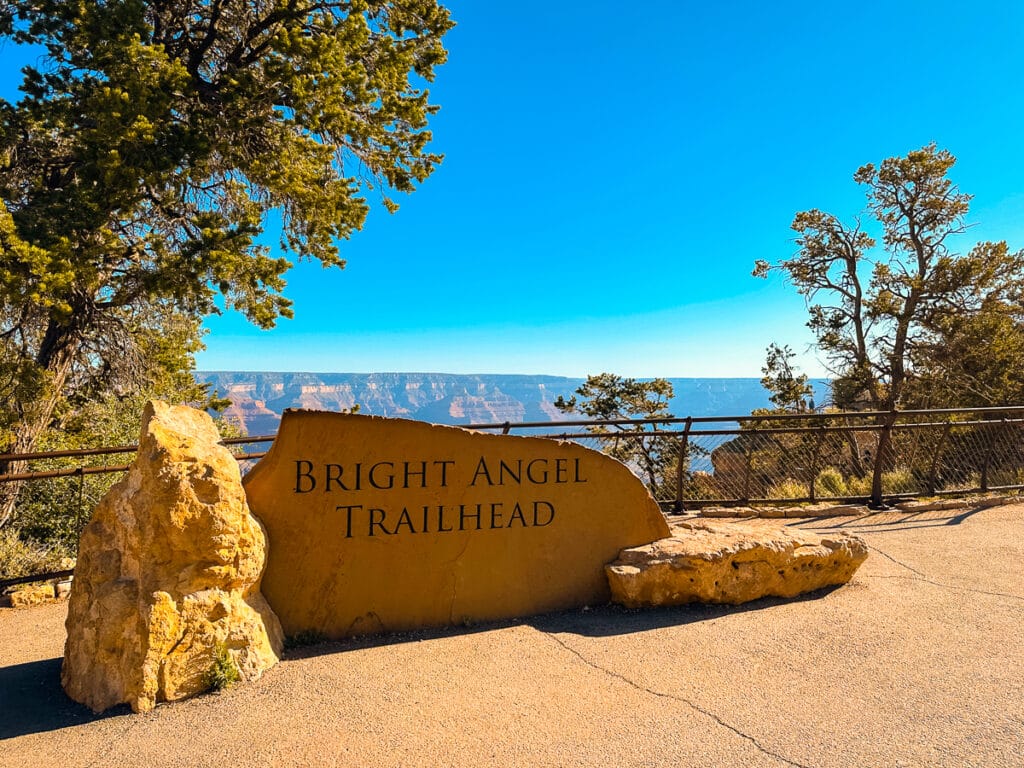
If you’re looking for a taste of hiking below the rim, you can walk a short distance down the trail and back. If you want the ultimate adventure, you can trek 4,000+ feet down to Phantom Ranch and the Colorado River!
Here’s a quick, at-a-glance of the various roundtrip distances to destinations along the Bright Angel Trail:
- First Tunnel: 0.1 miles / Limited elevation change / 20 minutes
- Second Tunnel: 1.8 miles / 590 feet elevation / 1-2 hours
- 1.5-Mile Resthouse: 3 miles / 1,120 feet elevation / 2-4 hours
- 3-Mile Resthouse: 6 miles / 2,120 feet elevation / 4-6 hours
- Havasupai Gardens (formerly Indian Gardens): 9 miles / 3,040 feet elevation/ 6-9 hours
- Plateau Point: 12 miles / 3,080 feet elevation / 9-12 hours
- River Resthouse: 16 miles / 4,380 feet elevation / 12-15 hours
- Phantom Ranch: 19.8 miles / 4,380 feet elevation / 15-18 hours
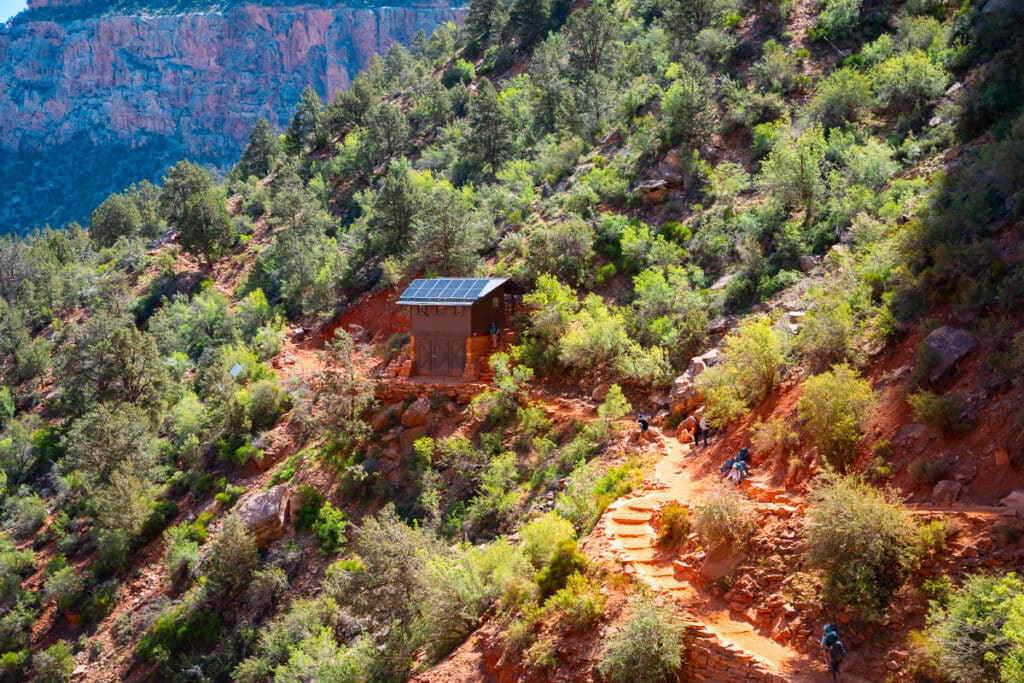
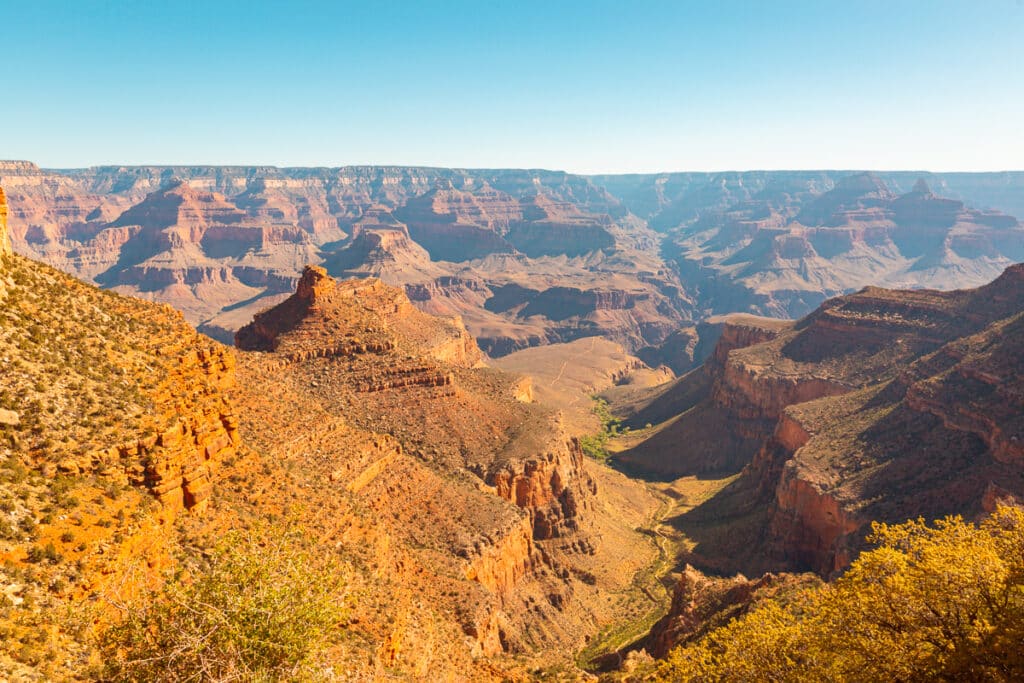
In the summer, start your hike early, around sunrise, to beat the heat and pack plenty of water (which isn’t available along the trail!).
The National Park Service strongly discourages going past Plateau Point on a day trip. Instead, opt for a guided mule tour or stay the night at Phantom Ranch. As a rule of thumb, estimate that it will take at least twice the amount of time to come back up the trail than it did to go down.
3. Hike the South Kaibab Trail
The South Kaibab Trail is another incredibly popular hike at the Grand Canyon South Rim. The trail starts at the South Kaibab Trailhead, easily accessible via the Grand Canyon shuttle, before navigating to the Colorado River.
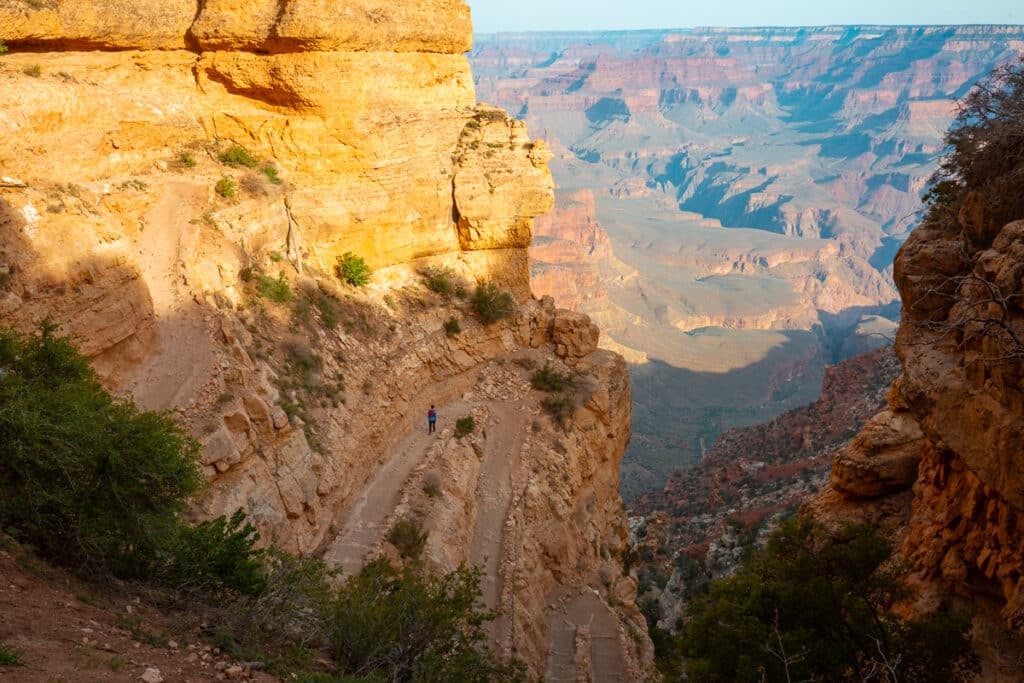
The stunning trail plunges nearly 5,000 feet to the canyon floor, offering panoramic views from within the Grand Canyon. Like the Bright Angel Trail, hikers looking for a taste of hiking below the rim can turn back at Ooh Aah Point, making for a 2-mile round trip hike.
From Ooh Aah Point, you’re rewarded with sweeping views overlooking the canyon to the north, west, and east! Ooh Aah Point is also an excellent place for sunrise if you’re looking to escape the crowds!
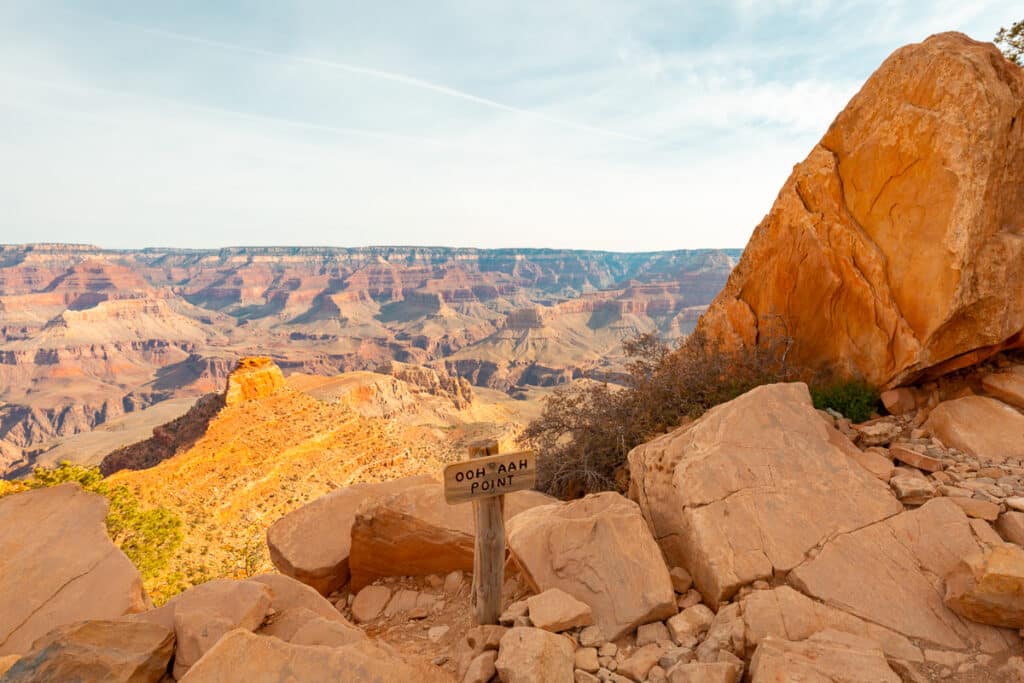
Past Ooh Aah Point, the trail continues to descend to more panoramic viewpoints, but the return hike is strenuous! If you’re only in the Grand Canyon briefly, the hike to Ooh Aah Point is the perfect option.
Here’s a quick, at-a-glance of the various roundtrip distances to destinations along the South Kaibab Trail:
- Ooh Aah Point: 1.8 miles / 600 feet elevation / 1-2 hours
- Cedar Ridge: 3.0 miles / 1,140 feet elevation / 3-4 hours
- Skeleton Point: 6.0 miles / 2,060 feet elevation / 6-8 hours
- Tip Off Point: 8.9 miles / 3,254 feet elevation / 7-9 hours
- Phantom Ranch: 14.3 miles / 4,872 feet elevation / 12-15 hours
Like the Bright Angel Trail, the National Park Service strongly discourages going to Phantom Ranch and back on a day trip, particularly in the summer. Instead, consider making a trip to the canyon floor into a multi-day backpacking trip.
4. Take the Shuttle or Bike to the Hermit Road Viewpoints
If you’ve already visited the viewpoints in Grand Canyon Village, don’t miss making the trip out to all the stunning vistas along Hermit Road. This 7-mile scenic drive is closed to vehicles from March 1 to November 30, so the best way to access these viewpoints is either on the park shuttle or by bicycle.
The Grand Canyon Red Route shuttle starts in Grand Canyon Village and runs to Hermit’s Rest.

If you prefer to bike instead, rent bicycles from Bright Angel Bicycles near the visitor center and bike the greenway trail to the start of Hermit Road.
While I think it is worth it to stop at every single vista, these are my favorites along Hermit Road:
- Powell Point offers panoramic views of the canyon and the distant horizon, perfect for early morning or the golden hour before sunset.
- Hopi Point is only a short walk (0.3 miles) past Powell Point along the Rim Trail. This viewpoint is one of the best in the park for sunset, with 270-degree views and glimpses of the Colorado River.
- Mohave Point is located another mile past Hopi Point. It offers incredible views of the canyon’s rock features and the Colorado River. Mohave Point is an excellent viewpoint at midday or for a less-crowded sunset.
- Hermit’s Rest is the final stop along Hermit Road, offering a historic snack bar designed by Mary Colter. This last stop is an excellent spot to refuel before taking the shuttle back to Grand Canyon Village or biking along Hermit Road.
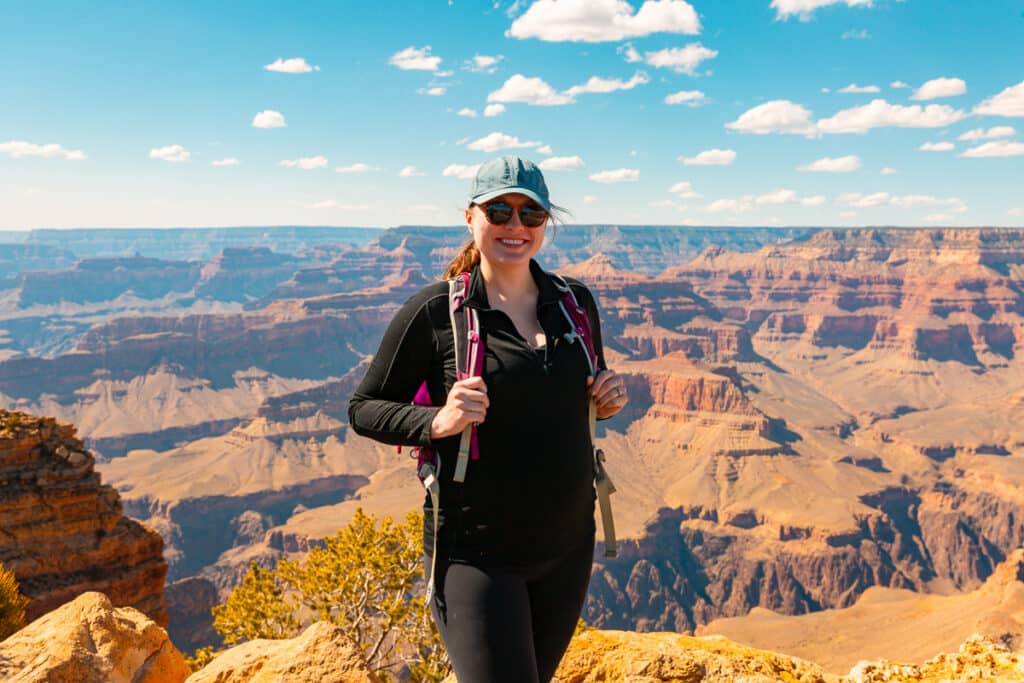
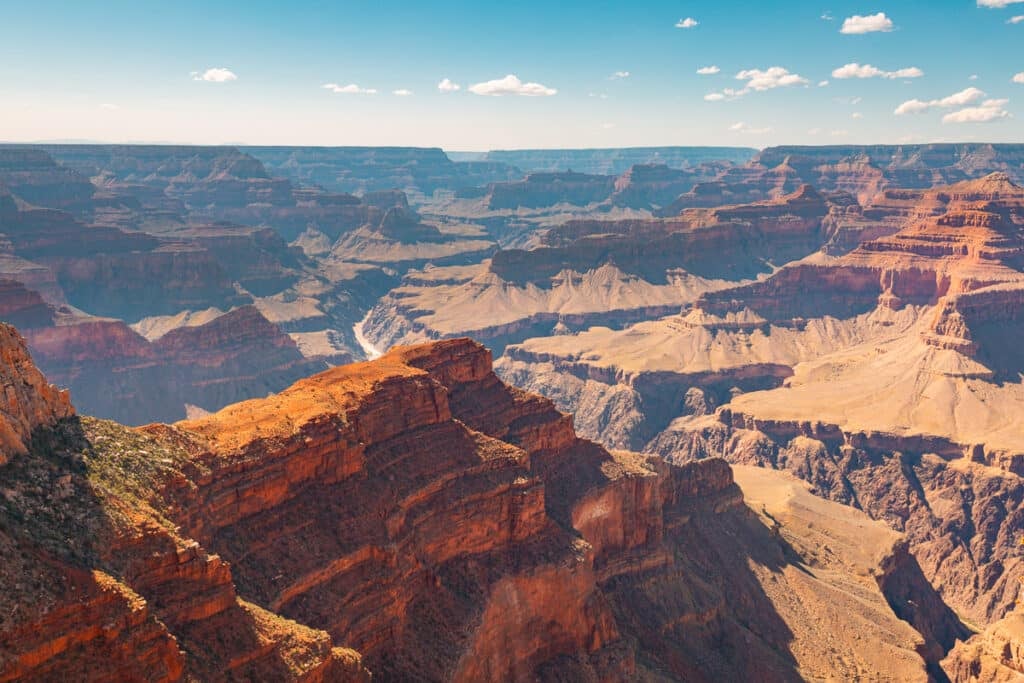
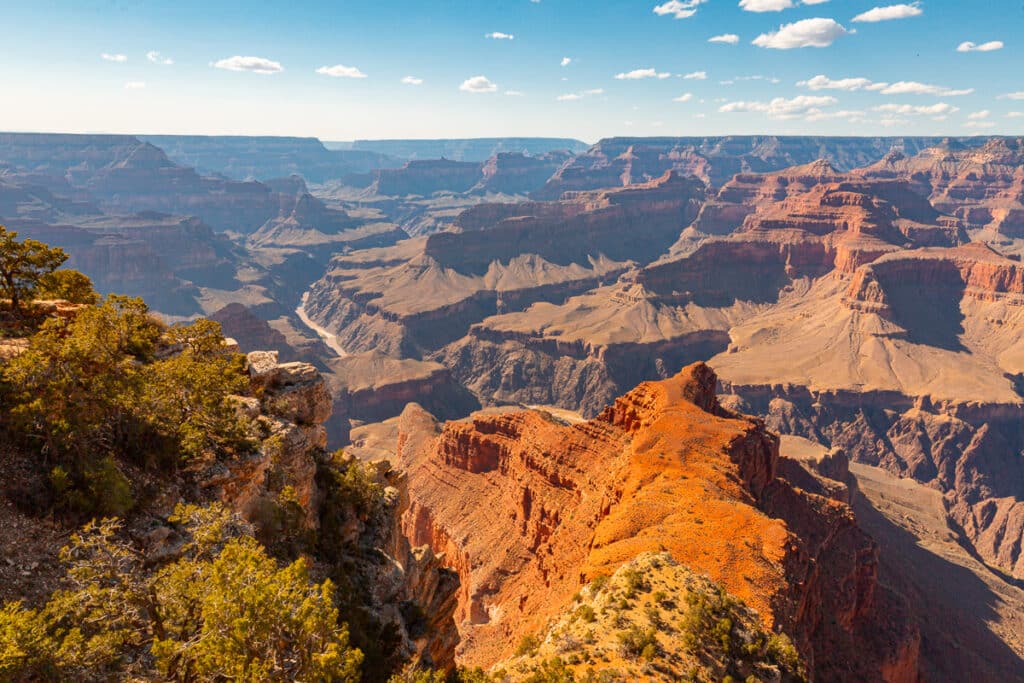
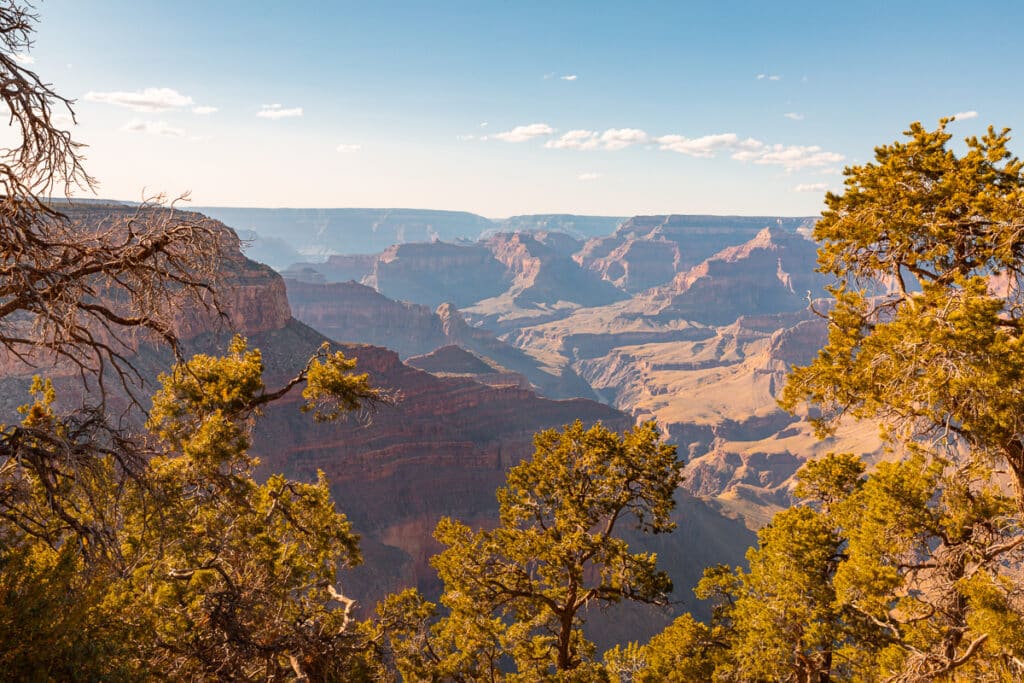
5. See the Viewpoints Along Desert View Drive
While it takes a bit more effort to reach the viewpoints along Desert View Drive, it’s well worth the trip, particularly if you’ve already explored Grand Canyon Village and Hermit Road.
This 23-mile scenic route heads east from the Grand Canyon Visitor Center to the Desert View Watchtower. Unlike other park areas, the free shuttle does not extend along Desert View Drive. To see these viewpoints, you’ll need to drive your vehicle.

These are the must-see viewpoints along Desert View Drive:
- Desert View Watchtower is a 5-story, 70-foot watchtower designed by Mary Colter to blend into the natural landscape of the Grand Canyon. You can tour the historic building or simply take in the spectacular views from the lookout, with expansive canyon views to the west and views of the Painted Desert to the east.
- Navajo Point provides impressive views of the Colorado River and the Desert View Watchtower in the distance. It’s also the highest point along the South Rim at 7,498 feet above sea level!
- Lipan Point offers unique views of several rock formations and the Colorado River. Far below, on the canyon floor, you can glimpse the Grand Canyon’s indigenous history in the ruins along the delta.
- Tusayan Ruin is one of the most fascinating sites along Desert View Drive. These ancient ruins contain artifacts dating back 2,000 to 4,000 years! You can take a self-guided walking tour through the Ancestral Pueblo village along the Tusayan Pueblo Trail and stop at the Tusayan Pueblo Museum to learn more.
- Moran Point is my favorite viewpoint along Desert View Drive. Named after the famous landscape artist Thomas Moran, Moran Point offers stunning vistas of the Red Canyon and the bend of the Colorado River. This viewpoint is a breathtaking spot for sunrise or early morning golden hour.
- Grandview Point is located at the site of the first hotel at the Grand Canyon (which has since been demolished). For the best views, take a short walk down the Grandview Trail. Here, the views open up to both the east and the west, unobstructed by the tree line.
- Shoshone Point requires a 2-mile roundtrip hike, making this an excellent option for those looking to escape the crowds. In the late afternoon, this viewpoint glows as the sun reflects off the winding Colorado River below.
- Yaki Point requires visitors to take the Grand Canyon shuttle, as personal vehicles aren’t allowed to park here. This viewpoint provides glimpses of Phantom Ranch along the canyon floor and is an excellent place to watch the sunset.
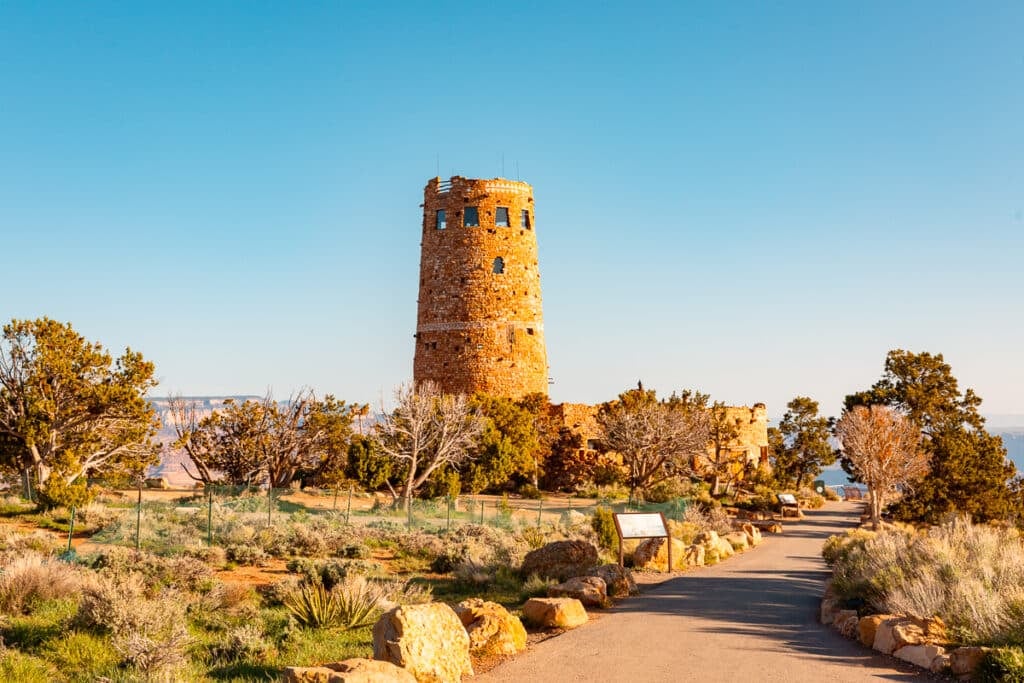
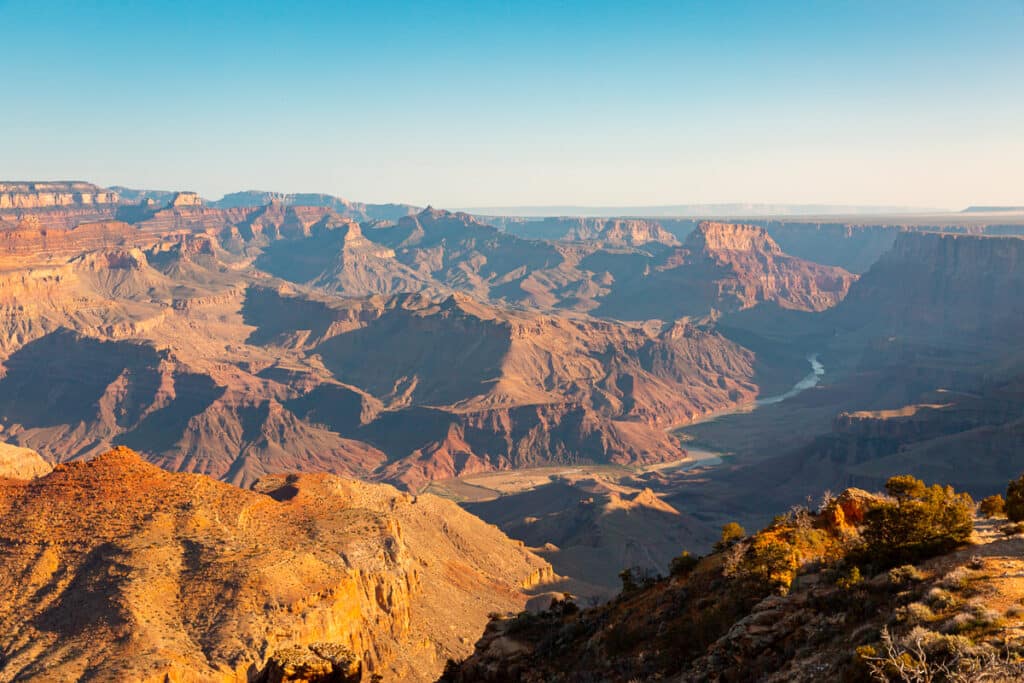
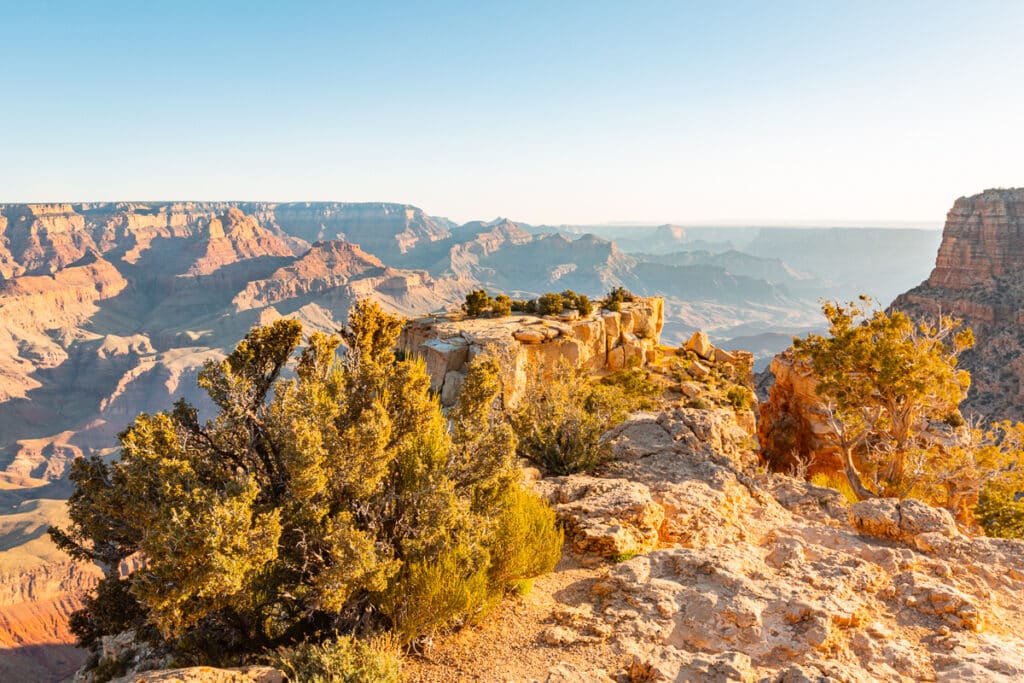
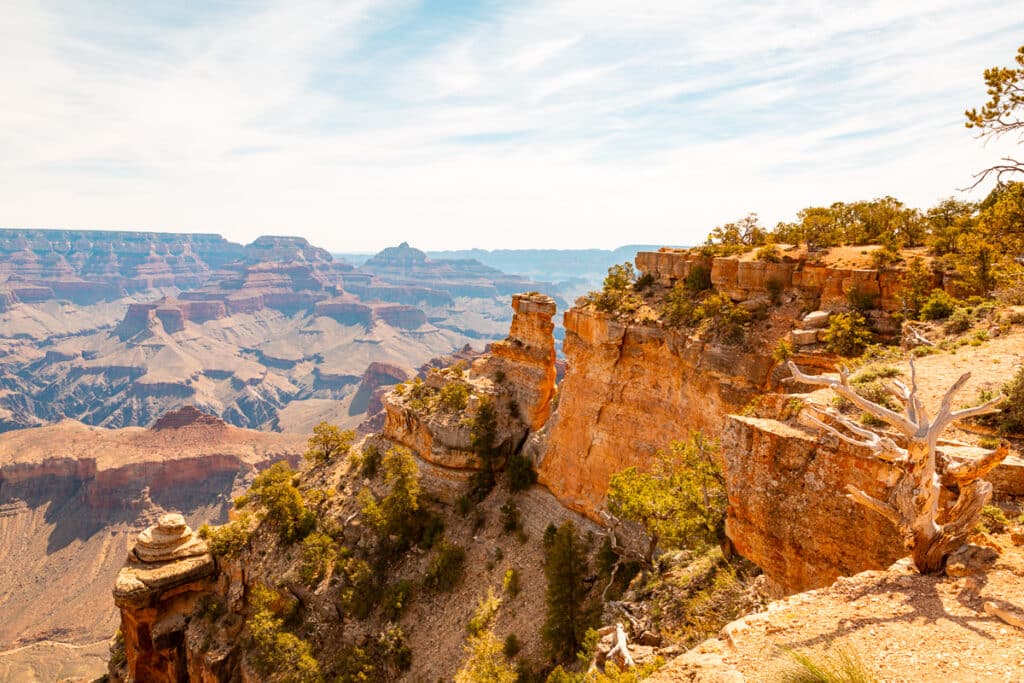
6. Walk a Portion of the Rim Trail
The South Rim Trail stretches along the edge of the Grand Canyon, providing unprecedented views of the canyon below. This walking trail is mostly paved, making it one of the best handicap-accessible activities in the park.
Stretching east-west along the South Rim, the Rim Trail covers 13 miles between the South Kaibab Trailhead and Hermit’s Rest. The best part about this trail? You don’t have to walk the entire 13 miles to enjoy it!

Grand Canyon National Park’s shuttle connects many of the Rim Trail’s most famous viewpoints, allowing visitors to explore short segments of the Rim Trail instead. The trail features plenty of benches for a quick rest and occasional informational displays to learn more about the park.
Most of the Rim Trail is pedestrian-only (no bicycles). However, two stretches are bicycle-friendly: Monument Creek Vista to Hermit’s Rest and South Kaibab Trailhead to Mather Point.

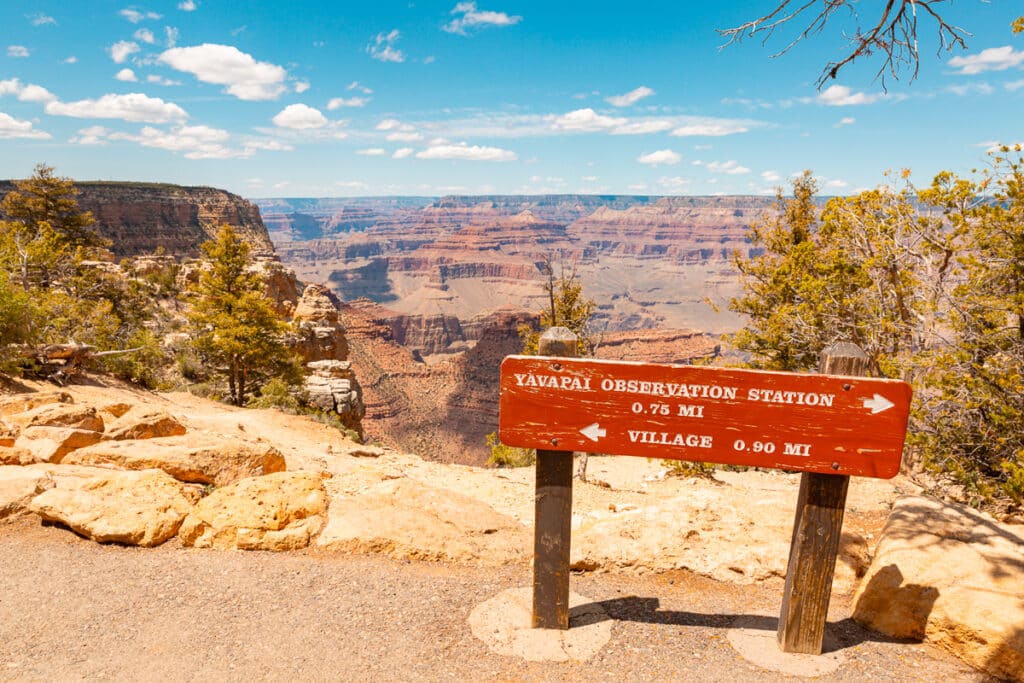
These are the segments of the Rim Trail I highly recommend exploring on foot:
- Trail of Time from Verkamp’s Visitor Center to the Yavapai Geology Museum (1.4 miles)
- Grand Canyon Village between Verkamp’s Visitor Center and Bright Angel Trailhead (0.5 miles)
7. Visit the Yavapai Museum of Geology
One of the best places to learn about the geology of this natural wonder of the world is the Yavapai Museum of Geology. Not only is the museum stunning, but it offers the best educational displays on the formation of the Grand Canyon.
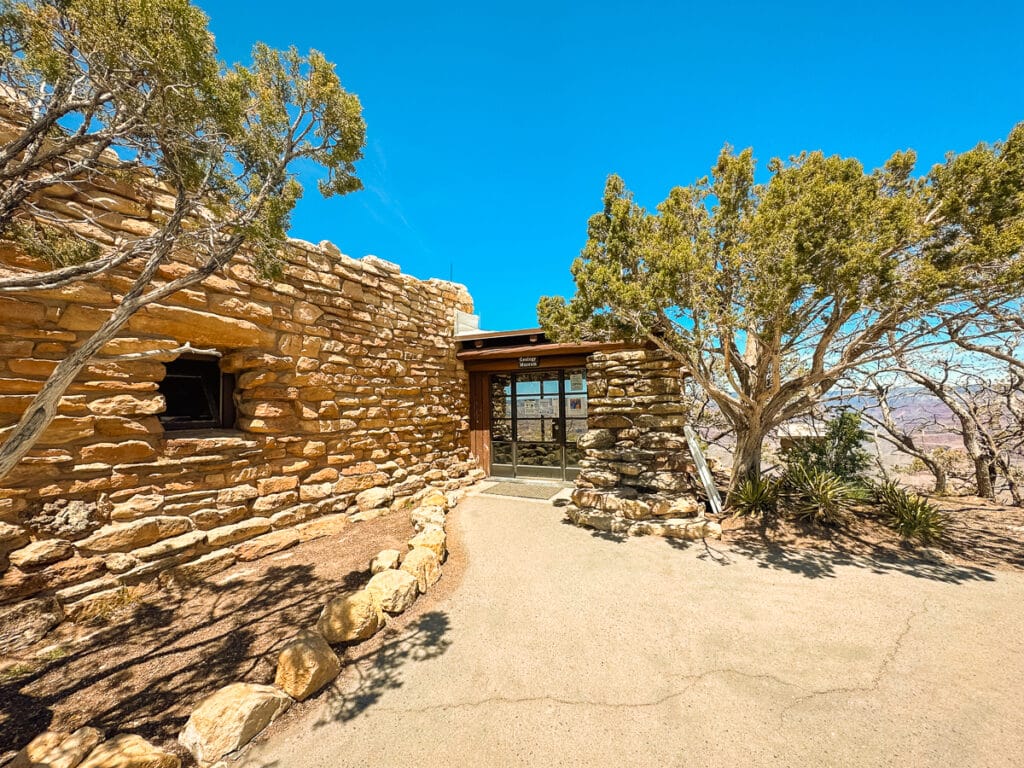
The museum is next to Yavapai Point, providing excellent views of the Grand Canyon from above. The glass-paneled, panoramic observation station allows you to see some of the canyon’s most spectacular features presented along with information on the canyon’s geological layers.
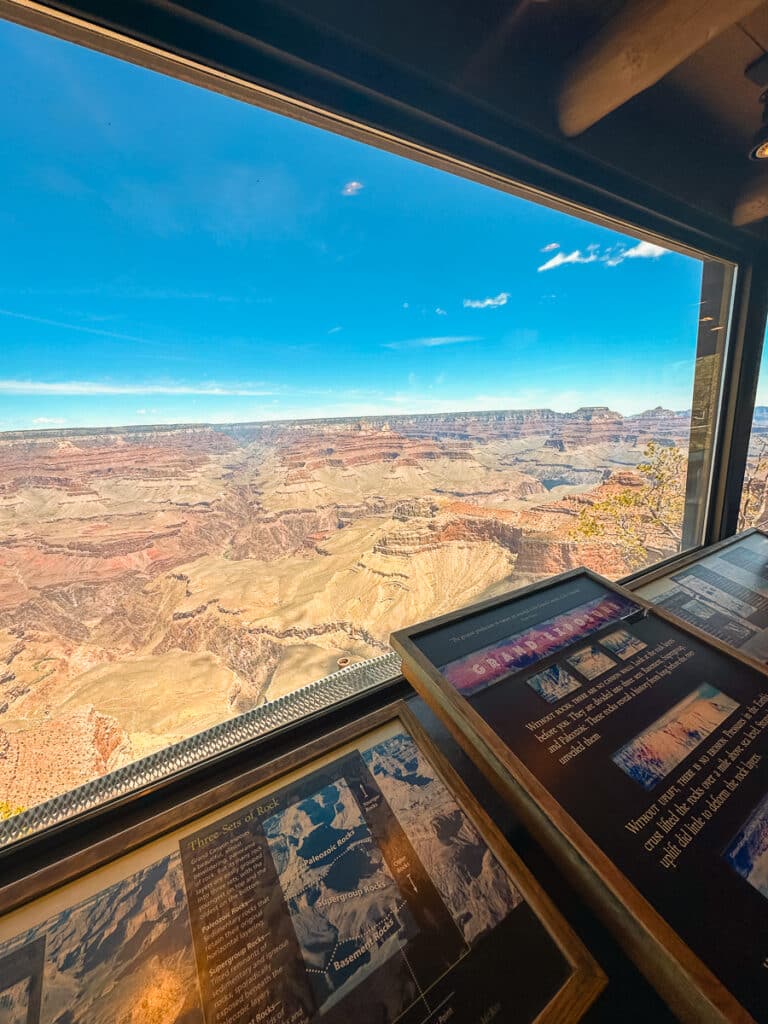
If you’re looking for a gift or souvenir, the Yavapai Geology Museum also has a small gift shop!
8. Walk the Trail of Time
The Trail of Time is a short, paved section of the South Rim Trail that provides exciting insight into the age of the rocks that make up the Grand Canyon. Since the trail is paved, this is an excellent, accessible activity.
The 1.4 miles between Verkamp’s Visitor Center and the Yavapai Geology Museum has informational signs every tenth of a mile to explain the geological layers of the canyon. The route is laid out chronologically, tracing billions of years of history.
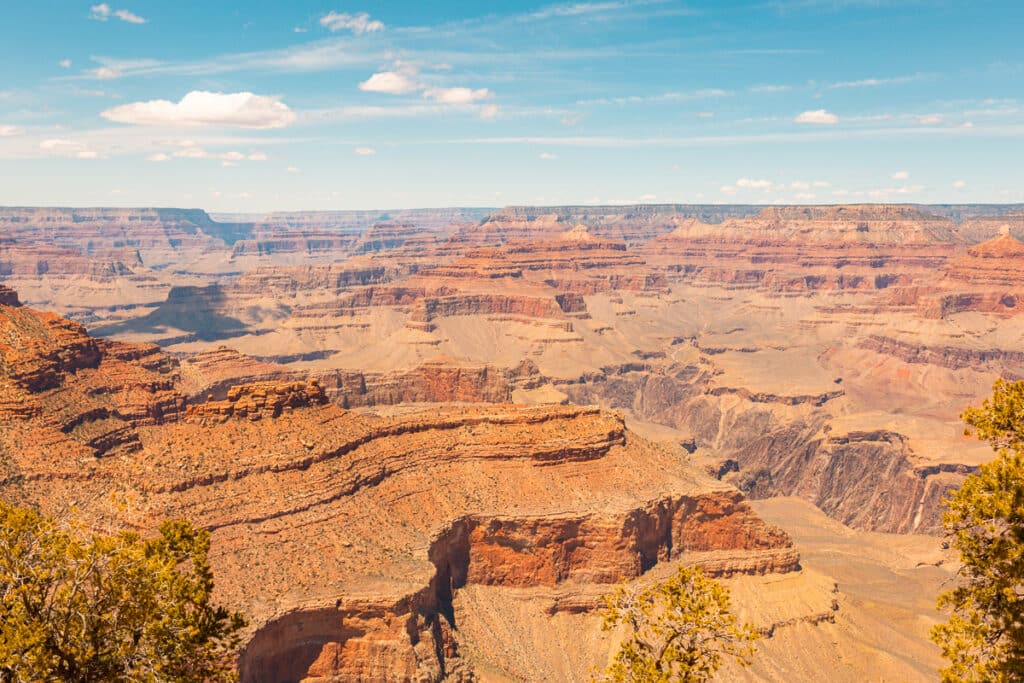
As you walk, you’ll see large rock samples along the path, located at the “timestamp” at which they were deposited into the canyon. This experience truly gives you an understanding of how old the Grand Canyon is!
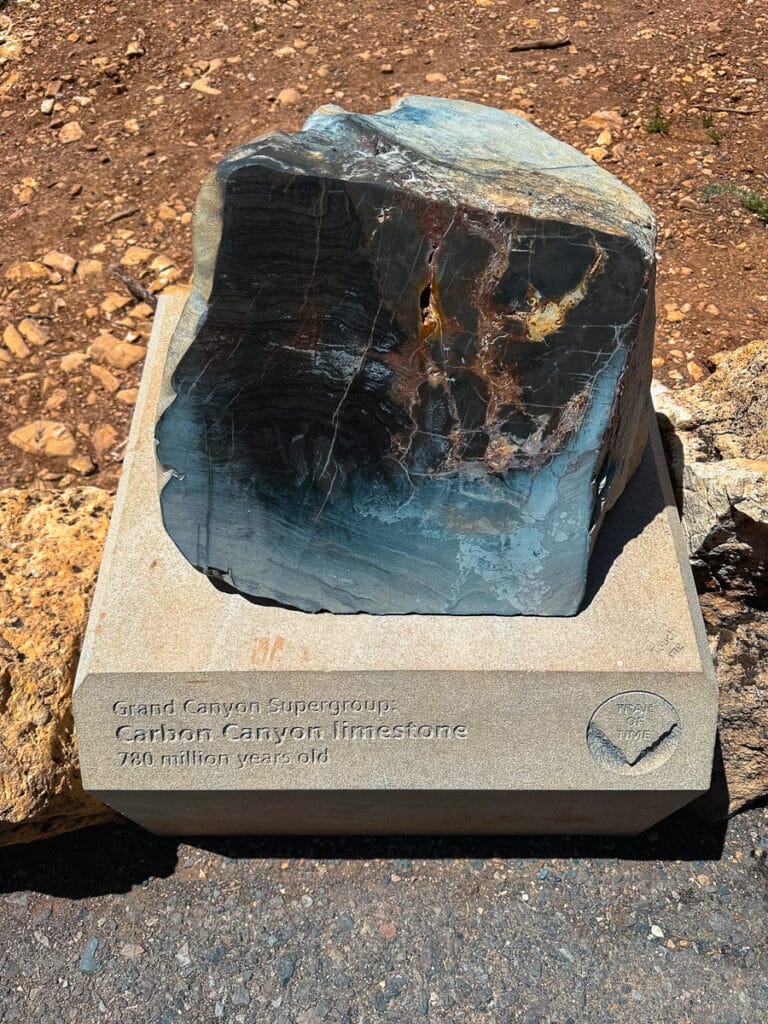
Since the path is chronological, you can walk it from either direction. If you start at Verkamp’s Visitor Center, you’re walking forward in time (beginning billions of years ago and ending today). If you start at Yavapai Geology Museum, you’re walking back through time (starting today and ending billions of years ago).
9. See Sunrise Over the Grand Canyon
Catching a sunrise is one of the most spectacular ways to see the Grand Canyon. The dawn’s pastel reds and pinks paint the canyon’s orange rocks in a fiery glow. It’s a can’t-miss experience.
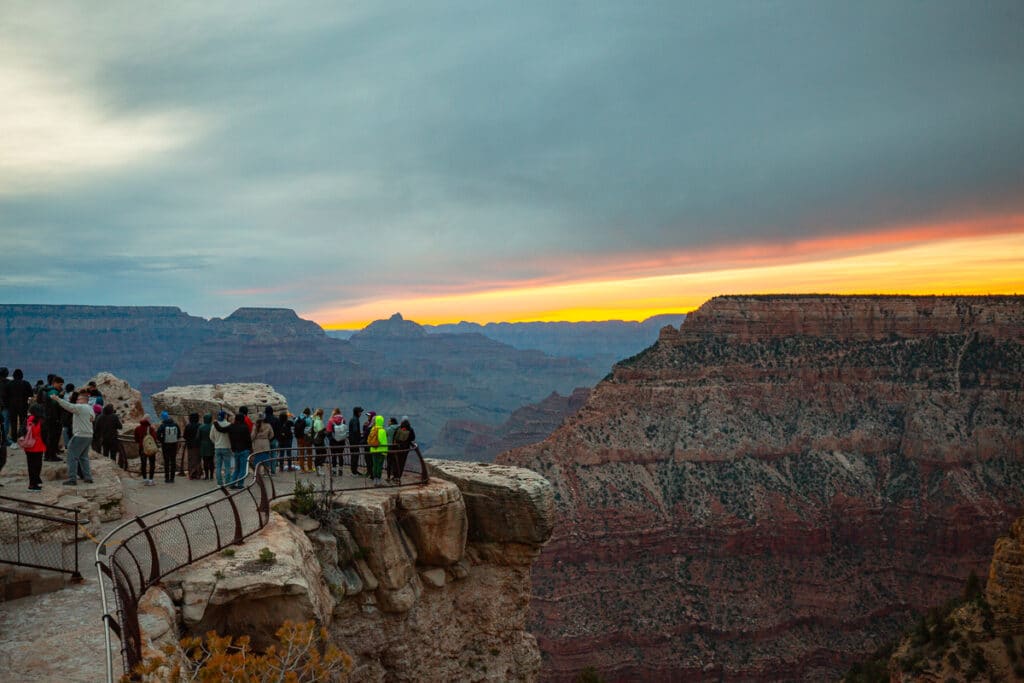
While there are several places to see sunrise in Grand Canyon National Park, there are a few that truly stand out from the rest:
- Mather Point is the most popular sunrise spot in the park. This viewpoint is easily accessible, located a short walk from the Grand Canyon Visitor Center. From Mather Point, you can choose between east-facing views of the sun rising over the distant mountains or west-facing views of the light bouncing off the canyon walls.
- Ooh Aah Point is the perfect sunrise spot for those looking to escape the crowds. This viewpoint is about a mile (and 600 feet down) along the South Kaibab Trail. To catch the sunrise at this spot, you’ll need to set out about an hour before sunrise. Don’t forget a headlamp!
10. See the Sunset at Grand Canyon National Park
If you aren’t an early riser, catching a sunset in the Grand Canyon instead of sunrise may be more your speed. There’s no shortage of beautiful spots to see the sunset. Like at sunrise, the canyon is illuminated in lush pinks and purples and comes aglow with fiery oranges and reds.
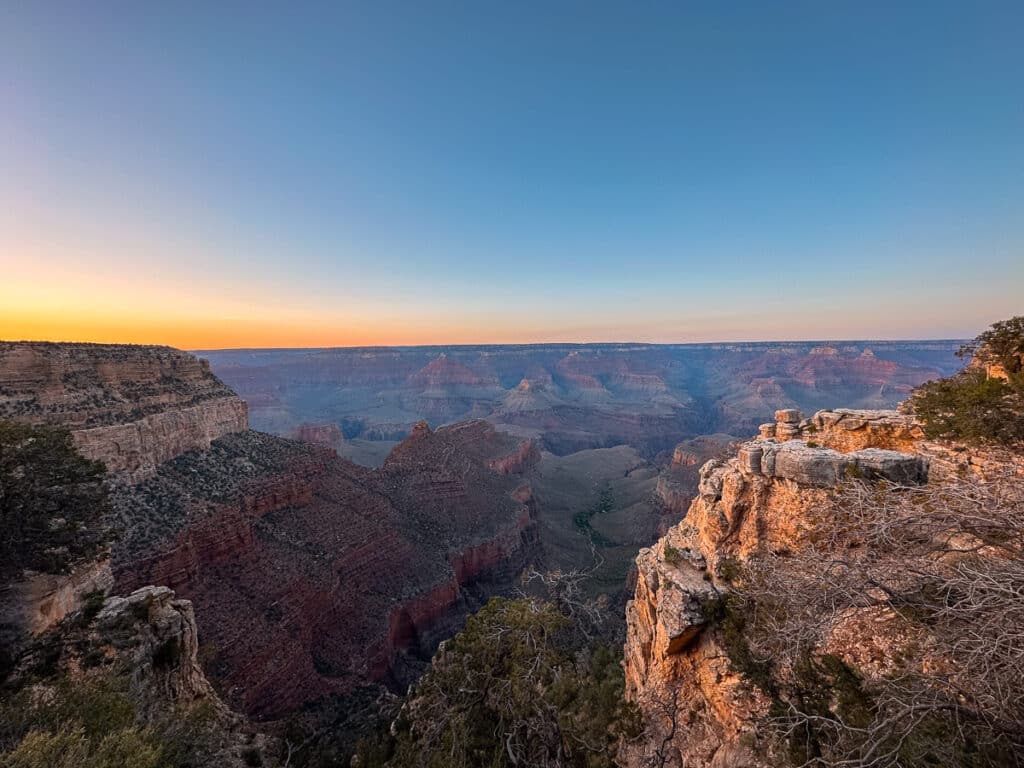
While any vantage point over the canyon is stunning during the evening golden hour and sunset, there are a few viewpoints that stand out above the rest:
- Hopi Point is the most popular (and most crowded!) sunset spot at the Grand Canyon. But once you see the views from here, it’s easy to understand why! Hopi Point offers 270-degree views of the canyon and the Colorado River along Hermits Rest Road. Just be sure to arrive early to snag a good observation spot!
- Desert View Watchtower requires a bit of driving to reach (about 40 minutes from Grand Canyon Village), but you’ll be rewarded with limited crowds. The viewpoint just past the historic watchtower provides panoramic views of the Colorado River, the Grand Canyon, and the painted desert to the east.
- Shoshone Point is a hidden gem located along Desert View Drive. If you’re seeking true sunset solitude, this is the place to go. Reaching Shoshone Point requires driving a 1-mile dirt road to the trailhead and then hiking a 2-mile roundtrip trail. However, once you get to the viewpoint, you’re rewarded with beautiful views overlooking the Colorado River far below.
11. Take a Mule Ride Into the Grand Canyon
If you’re looking for an experience that is unique to the Grand Canyon or want to explore the depths of the canyon without all that hiking, consider booking a mule ride.
Xanterra, the official hospitality company of the Grand Canyon, offers daily mule trips from the South Rim year-round. The journey begins along the Rim Trail, where you’ll meet your guide and trusty mule before heading out for the excursion.
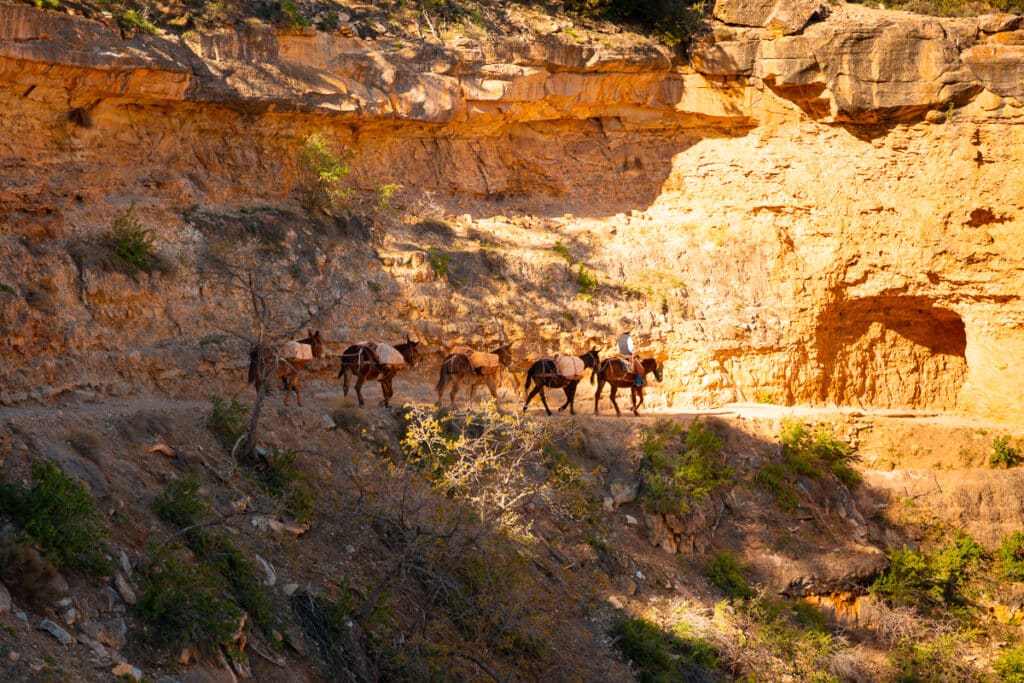
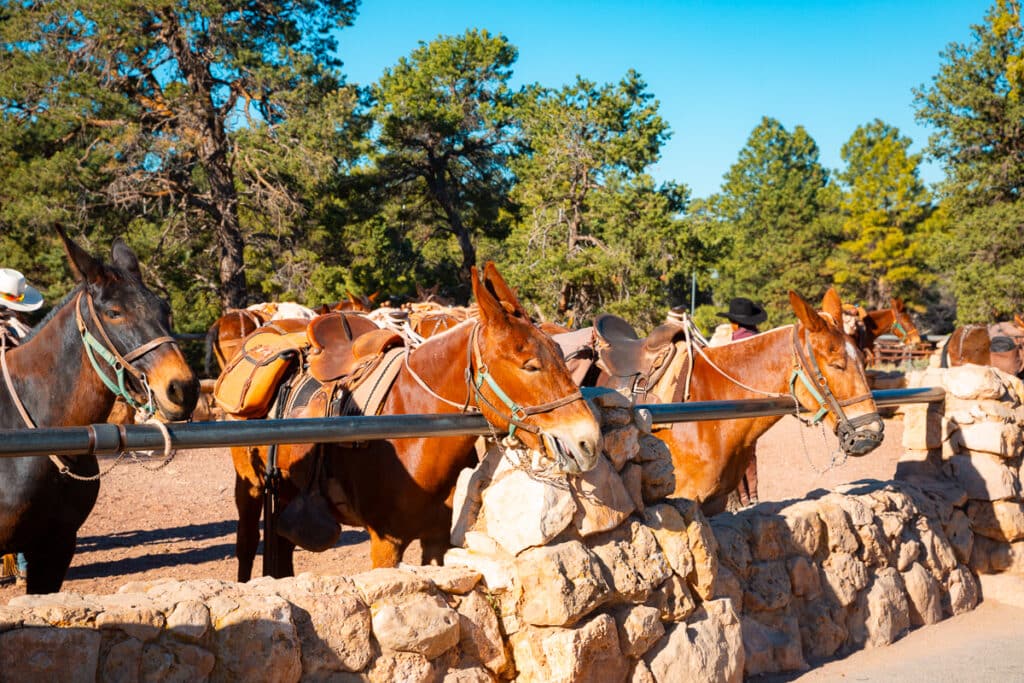
Visitors have two options for mule rides:
- 2-Hour Tour: This tour begins at Yaki Barn in Grand Canyon Village and takes you along the East Rim Trail. The tour includes plenty of narration about the park’s beauty and history as you ride.
- Overnight Tour: This highly-coveted tour begins at Bright Angel Trailhead and takes you to the canyon floor, where you’ll stay overnight at the bucket-list-worthy Phantom Ranch camp.
It’s important to note that the mule rides are not cheap. Averaging more than $150 per person for the two-hour tour and more than $700 per person for the overnight tour. Additionally, due to the limited capacity of Phantom Ranch, the reservations for overnight tours are hard to come by.
12. Hike to the Bottom of the Grand Canyon
For the true adventure seeker, hiking to the bottom of the Grand Canyon (and, of course, back up!) is a bucket list experience. It’s no easy feat to hike in and out of the canyon, totaling 10+ miles one way and 6,000 feet in elevation.
The “easiest” way to hike to the bottom of the Grand Canyon is to make it a multi-day journey, connecting two of the park’s most popular trails. Start at the South Kaibab Trailhead, hiking down the South Kaibab Trail to either Phantom Ranch or Bright Angel Campground to spend the night. The following day, you’ll return to the rim on the Bright Angel Trail.
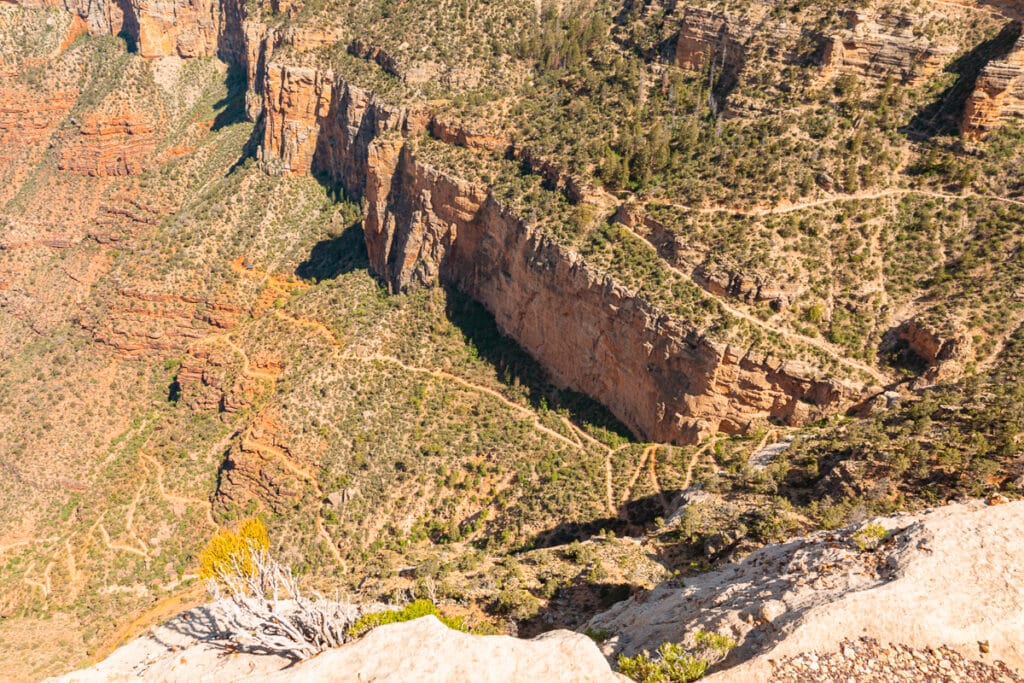
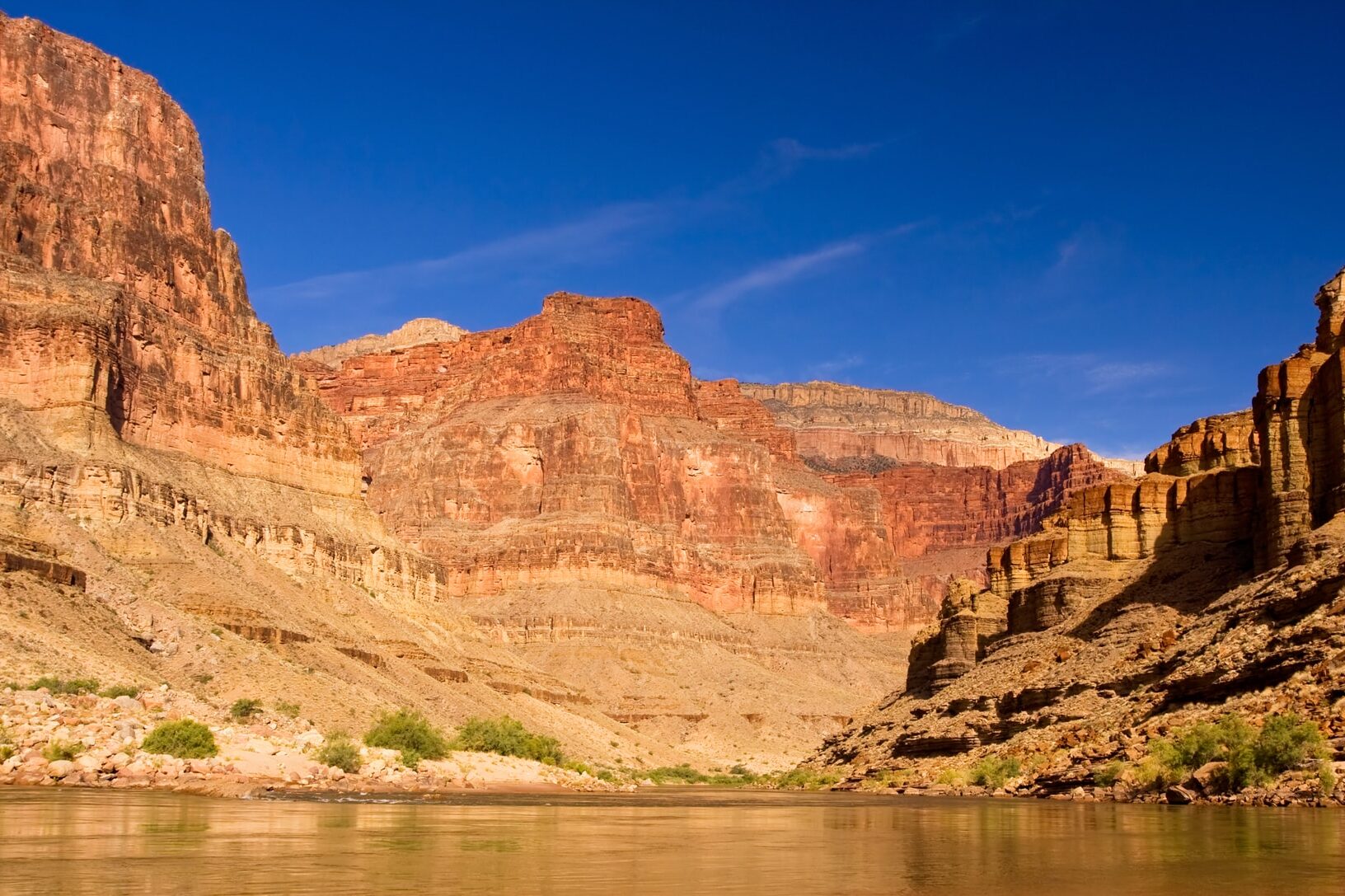
While the hike from the South Kaibab Trail to the Bright Angel Trail can theoretically be done in one day, the National Park Service (and myself!) do not condone this. The National Park Service doesn’t recommend anyone hiking to the bottom of the canyon and back in one day.
However, if you’re an endurance athlete capable of hiking nearly 20 miles and 6,000 feet of elevation, it may be possible to hike to the bottom of the canyon and back in one day.
When hiking in the Grand Canyon, particularly if you’re heading down into the canyon and back, it’s crucial to avoid hiking in the middle of the day. Temperatures in the canyon can reach 20+ degrees hotter than the temperature at the rim. Additionally, most trails do not offer water along the route, so pack at least 0.5-1L of water per hour you plan to hike.
13. Stop in at the Grand Canyon South Rim Visitor Center
Be sure to stop by the Grand Canyon Visitor Center during your time at the South Rim. The visitor center is an excellent place to learn more about the park, join a ranger program, speak to a park ranger, or get tips on the Grand Canyon shuttle or things to do.
The visitor center is located in Grand Canyon Village. It features a large parking area and the hub for the Grand Canyon shuttle system. I highly recommend parking at the visitor center and using the shuttle around Grand Canyon Village and Hermits Rest Road.
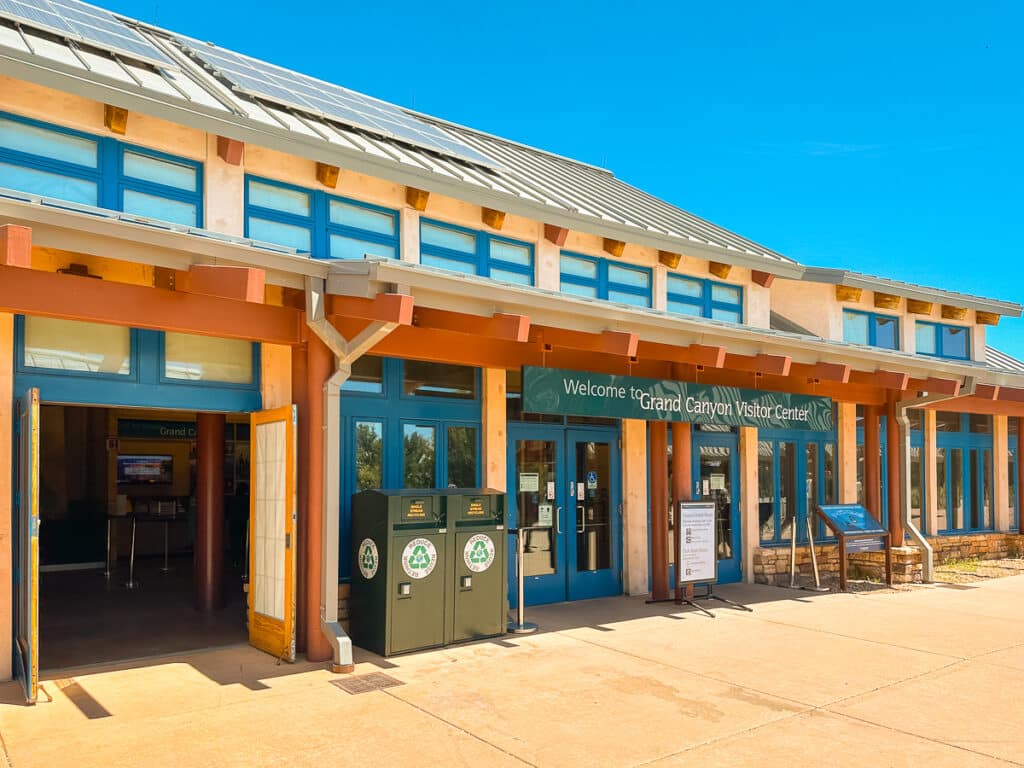
While at the visitor center, try some pastries or to-go food from Bright Angel Cafe. This cafe has some of the best food in the park. It’s also where you can rent bicycles for the day.
Don’t forget to stamp your national park passport while at the visitor center!
14. Watch the Grand Canyon IMAX Movie at the Grand Canyon National Geographic Visitor Center
While not technically inside Grand Canyon National Park, stopping at the Grand Canyon National Geographic Visitor Center is worthwhile. Located just outside the park in Tusayan, this visitor center features an IMAX movie theater that plays a movie all about the Grand Canyon.
The 34-minute film shows off the canyon’s many viewpoints and hikes. It’s the perfect introduction to the Grand Canyon, kicking off your trip as you head into the park. On hot summer days, the IMAX movie is a great way to escape the heat and enjoy air conditioning!
15. Visit the Hopi House
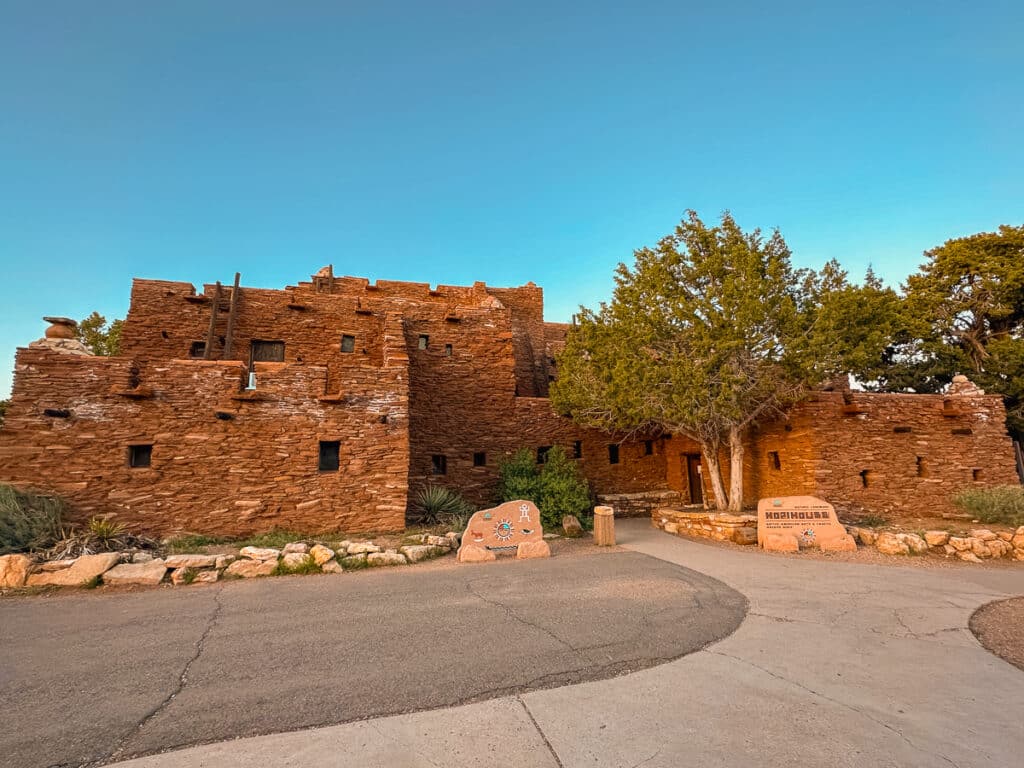
One of the many buildings in the park designed by famed architect Mary Colter, the Hopi House is home to unique jewelry, crafts, and other artifacts from the indigenous Hopi community who have called this area home for nearly one thousand years.
The Hopi House was built in a style to appear as a Hopi Pueblo. To glimpse the Hopi arts, explore the museum as you walk along the Rim Trail.
16. Mary Colter’s Lookout Studio
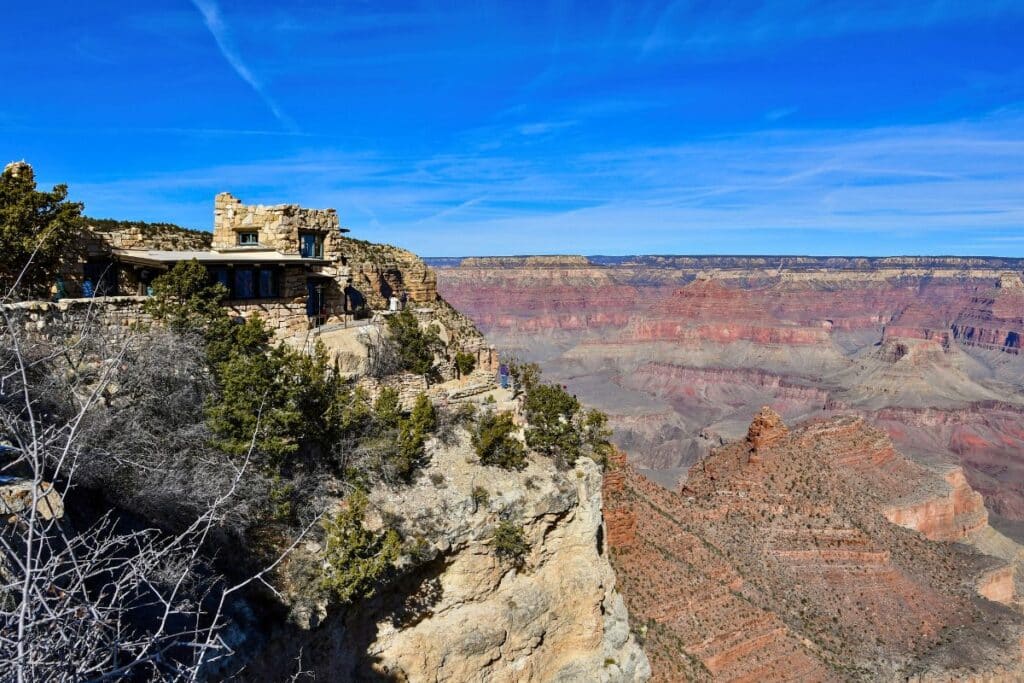
Mary Colter left her mark on the Grand Canyon’s South Rim thanks to her impactful designs of several buildings like the Hopi House, Hermit’s Rest, and Desert View Watchtower. The Lookout Studio is yet another building she designed and is dedicated to her legacy.
The Lookout Studio is perched over the canyon’s edge, seamlessly blending into the rocky outcrop. The studio, built in 1914, features an observation deck at the back, providing incredible views of the Bright Angel Trail and Colorado River along the bottom of the canyon.
17. Take a Ranger Guided Tour
One of the best ways to learn about the Grand Canyon’s geology and wildlife is by joining ranger-led programs. These tours, typically offered daily during peak season, provide unique insights and are perfect for families.
The tours and talks cover various topics, from geology lessons to the animals that inhabit the park, with activities including rim walks, stargazing, and more. You can read more about the ongoing ranger led programs from the National Park Service.
18. Take a Helicopter Flight Above the Grand Canyon
For a truly spectacular view of the Grand Canyon, consider taking a helicopter tour. These tours provide a unique perspective that cannot be experienced from the ground. However, this experience doesn’t come cheap! Helicopter tours typically start around $350 per person.
There are various options for departing from the private airport near the South Rim or Las Vegas. Each option offers an unforgettable aerial view of the canyon’s stunning beauty and grandeur.
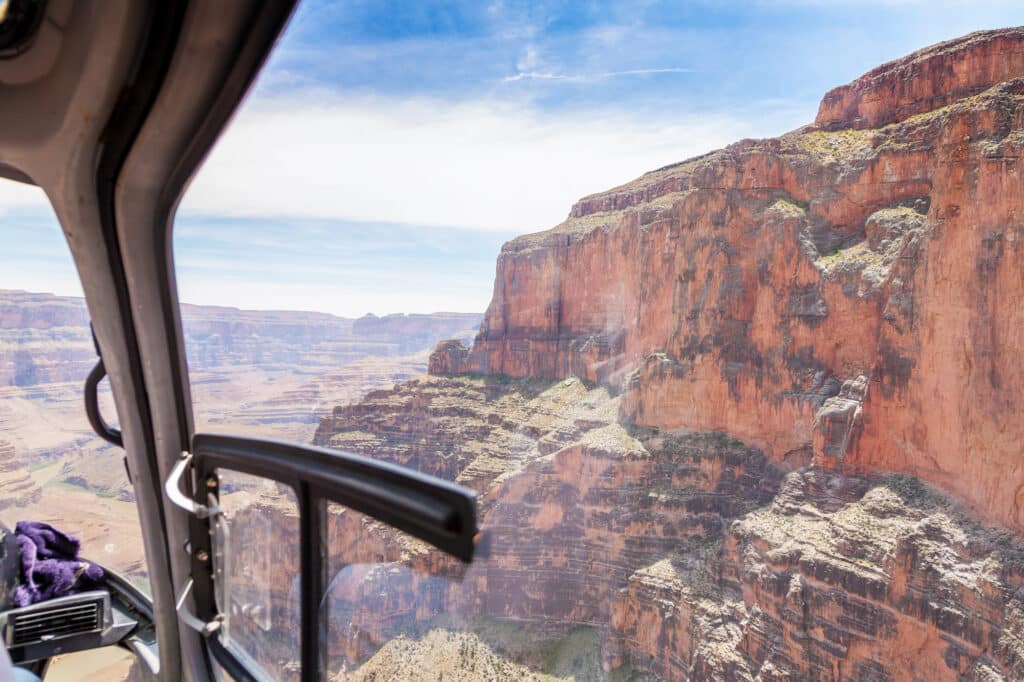
Here are the helicopter tours of the Grand Canyon that I recommend:
- South Rim: 45-Minute South Rim Helicopter Flight from Tusayan
- South Rim: 25-Minute South Rim EcoStar Helicopter Tour with Optional Hummer
- Las Vegas/West Rim: 3-Hour Grand Canyon West Rim Luxury Helicopter Tour
19. Go Rafting on the Colorado River
Satisfy your thirst for adventure with a whitewater rafting trip on the Colorado River. Going rafting in the Grand Canyon gives you a unique opportunity to see the canyon from the bottom!
With options ranging from single-day excursions to extensive multi-day journeys, there’s something for you! Here are some of the top-rated white water rafting excursions at the Grand Canyon:
- From Las Vegas: One Day Grand Canyon White Water Rafting Trip
- From Las Vegas: Grand Canyon Helicopter Flight with Colorado River Float Trip
- From Route 66: Self-Drive 1-Day Grand Canyon Whitewater Rafting Tour
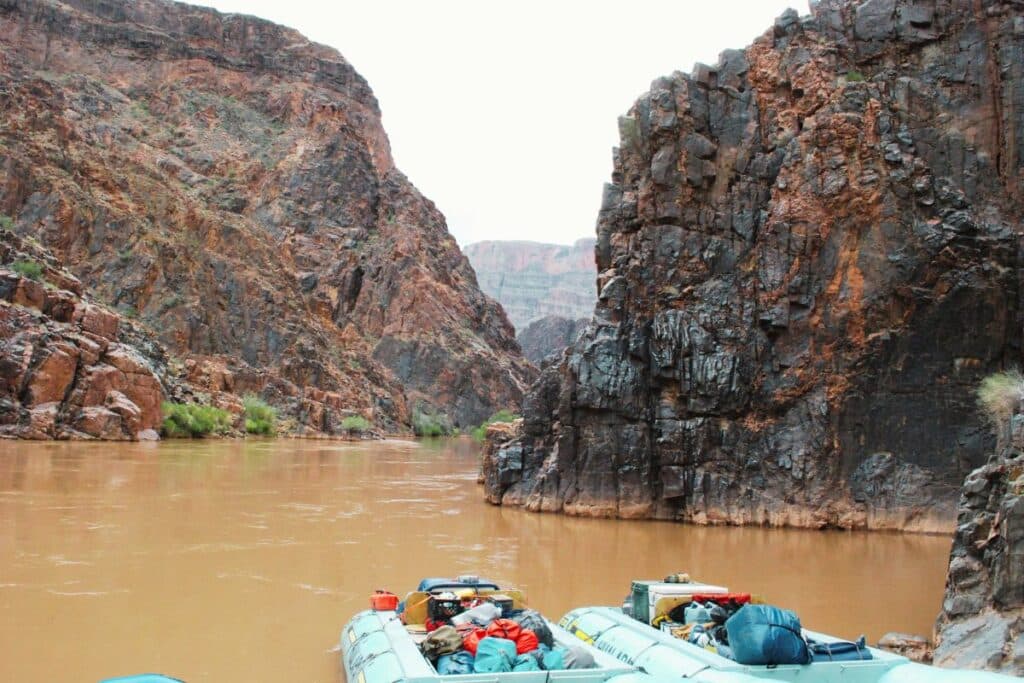
For multi-day rafting trips, check out this list of concessioners from the National Park Service.
20. See the Grand Canyon National Park Lodges
Immerse yourself in the history and rustic beauty of the Grand Canyon by visiting two of the park’s most popular and stunning lodges. The Bright Angel Lodge, designed by architect Mary Colter in 1935, offers a more affordable alternative to the luxurious El Tovar Hotel, which has hosted celebrities and tourists alike.
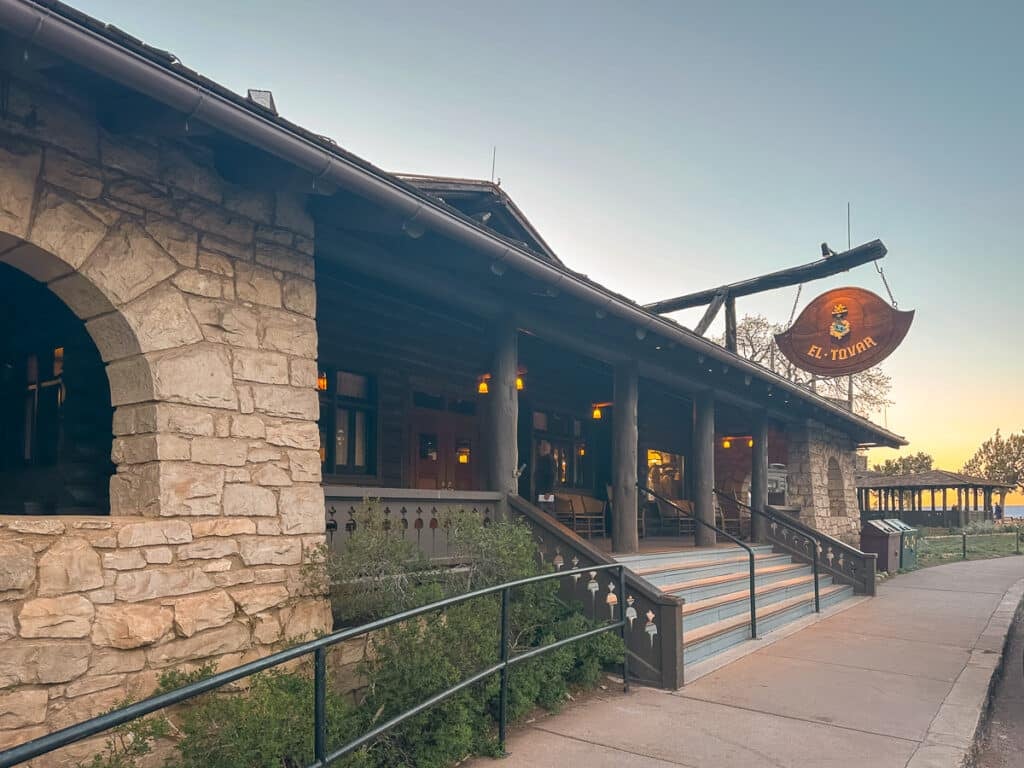
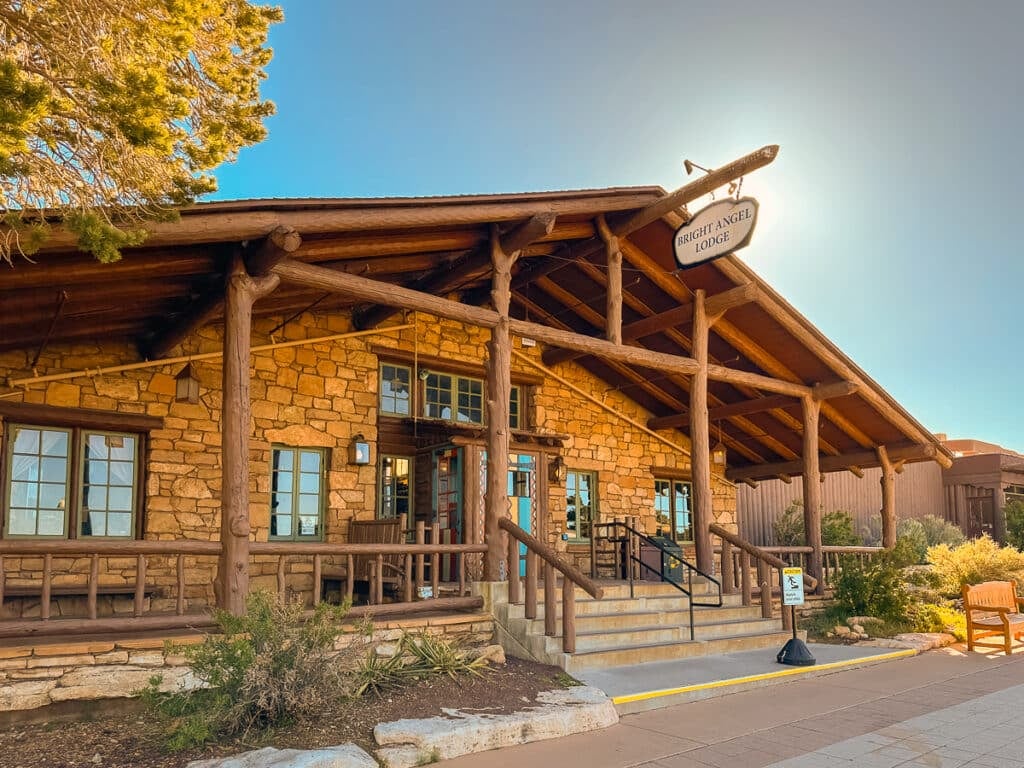
Both lodges are conveniently located along the Rim Trail near popular hiking trails and offer stunning canyon views.
21. Go Stargazing at the Grand Canyon
As an International Dark Sky Park, the Grand Canyon offers some of the best stargazing opportunities in the world. The South Rim is an excellent place to gaze upon the star-studded night sky and experience the true beauty of the Grand Canyon after dark.
While any place in the park provides incredible stargazing options, your best viewing spots will be away from the lights of Grand Canyon Village. I recommend driving out Desert View Drive to see the stars.
22. Ride the Grand Canyon Railway
Embark on a magical journey aboard the Grand Canyon Railway. This well-preserved vintage train has been in operation since 1901. Departing from Williams, Arizona, the train offers a unique and entertaining way to experience the beauty of the Grand Canyon, complete with musicians and cowboy characters.

The train then lets guests off at the Train Depot at the Grand Canyon South Rim, allowing for 3 hours of exploration. Within 3 hours, you can walk parts of the Rim Trail and see the famed park lodges.
If you want more time to explore, consider booking lodging inside the park and taking the train back the following day.
How Many Days Do You Need at the Grand Canyon South Rim?
While you can see the highlights and many scenic viewpoints at the Grand Canyon in just one day, you’ll get the best experience by spending two to three days in the park. With two or more days, you can do a few hikes, see all the scenic viewpoints, and explore at a more leisurely pace.
Suggested Grand Canyon South Rim Itineraries
If you’re looking for ideas on how to check off these incredible activities and things to do, consider one of these sample itineraries!
If You Only Have a Few Hours in the Grand Canyon
Park at the Grand Canyon Visitor Center and walk or take the shuttle to these Grand Canyon Village viewpoints:
- Mather Point
- Yavapai Point & Yavapai Geology Museum
- Trail of Time
- Hopi House
- El Tovar Hotel
- Bright Angel Hotel
- Mary Colter’s Lookout Studio
- Bright Angel Trailhead
If You Only Have One Day in the Grand Canyon
- Park at the Grand Canyon Visitor Center and take the shuttle to the South Kaibab Trailhead
- Hike the South Kaibab Trail to Ooh Aah Point
- Stop at Yaki Point on the way back to the visitor center
- Walk or take the shuttle to these Grand Canyon Village viewpoints along the Rim Trail:
- Mather Point
- Yavapai Point & Yavapai Geology Museum
- Trail of Time
- Bright Angel Trailhead
- Take the shuttle to the viewpoints along Hermit’s Rest Road, ending with sunset at Hopi Point
Read More: One Day Grand Canyon Itinerary
If You Have Two Days in the Grand Canyon
Day One:
- Park at the Grand Canyon Visitor Center and see the sunrise at Mather Point
- Grab breakfast at the Bright Angel Cafe (or save this for after the hike if they aren’t open yet!)
- Take the shuttle to the South Kaibab Trailhead and hike the South Kaibab Trail to Ooh Aah Point
- Stop at Yaki Point on the way back to the visitor center
- Explore the Grand Canyon Visitor Center and gift shop
- Drive out to Desert View Watchtower via Desert View Drive, stopping at each of the viewpoints on your return trip back to Grand Canyon Village
- End your day with dinner and sunset at one of the Grand Canyon lodges
Day Two:
- Start early and hike the Bright Angel Trail to 1.5 Mile Resthouse (or further if you’re up for the challenge!)
- Take the shuttle to all the viewpoints along Hermit’s Rest Road
- If you are looking for an excellent final sunset, stop at Hopi Point along Hermit’s Rest Road to end your trip
Looking for more details on the Grand Canyon viewpoints listed here? Check out this blog post on the best views in Grand Canyon National Park!
If You Have Three or More Days in the Grand Canyon
With three or more days, you’ll have plenty of time to explore the best of the Grand Canyon’s South Rim. In addition to the 2-day itinerary above, consider adding on a guided tour or excursion, such as:
- Taking a ranger-led tour
- Taking a helicopter flight over the Grand Canyon
- Riding the Grand Canyon Railway
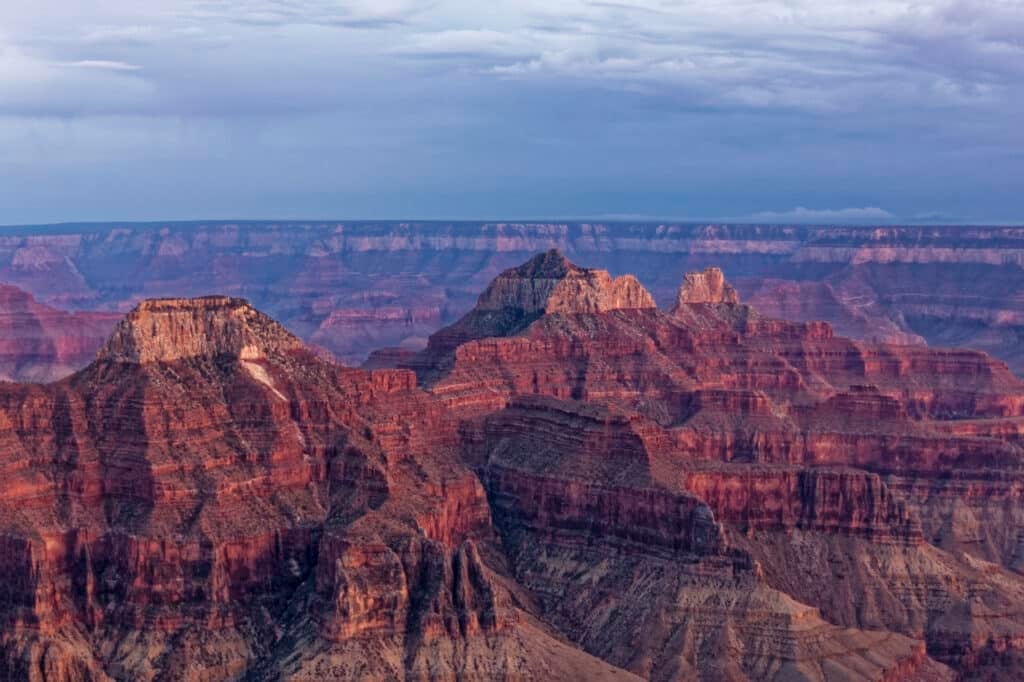
Best Things to Do Near Grand Canyon South Rim
If you’re planning a road trip to the Grand Canyon and the rest of the southwest, don’t miss these incredible “nearby” destinations:
- Flagstaff: A charming mountain town, Flagstaff serves as a gateway to the Grand Canyon and offers a mix of historic downtown, pine forests, and observatories (1.5 hours)
- Sedona: A mystical town set amidst striking red rock formations, Sedona is known for its vibrant arts scene and popular hiking trails (2 hours)
- Page: Home to natural wonders like Antelope Canyon and Horseshoe Bend, Page is a hub for scenic beauty and outdoor activities. Don’t miss relaxing on Lake Powell, too (2.5 hours)
- Monument Valley: Renowned for its iconic red buttes and mesas, Monument Valley offers a picturesque landscape that has graced countless Western films (3 hours)
- Petrified Forest National Park: A surreal landscape filled with fossilized logs and ancient petroglyphs, offering a deep dive into Earth’s prehistoric past (3 hours)
- Phoenix: As Arizona’s bustling capital, Phoenix is a blend of urban sophistication and desert charm, boasting a rich cultural scene, world-class golf courses, and the scenic Sonoran Desert landscapes (3.5 hours)
- Grand Canyon North Rim: Less visited than the South Rim, the North Rim offers a more off-the-beaten-path Grand Canyon experience in the summer months (4 hours)
- Grand Canyon SkyWalk: A horseshoe-shaped glass bridge suspended 4,000 feet above the West Rim canyon floor offers jaw-dropping panoramic views (4 hours)
- Hoover Dam: An engineering marvel on the Colorado River, the dam provides a unique look at American history and stunning views of Lake Mead (4 hours)
- Las Vegas: “Sin City” is an excellent gateway to the Grand Canyon, filled with world-class entertainment, casinos, and nightlife (4.5 hours)
- Zion National Park: A haven of towering red cliffs, cascading waterfalls, and serene emerald pools, Zion is the perfect national park pairing with Grand Canyon National Park (5 hours)
- Bryce Canyon National Park: Famous for its otherworldly hoodoos and amphitheaters, Bryce Canyon is a labyrinth of red rock spires that glow at sunrise and sunset (5 hours)
- Death Valley National Park: The hottest and driest national park, Death Valley is a landscape of extremes with vast dunes, rugged canyons, and colorful badlands (6 hours)
One of my favorite southwest road trips is this Grand Canyon + Zion itinerary! And if you have more time, a trip to the Grand Canyon also pairs perfectly with a road trip to all 5 Utah national parks!
If you want to check out more nearby national parks and sites, read these posts on the best national parks in Southern Utah and the best national parks near Las Vegas!
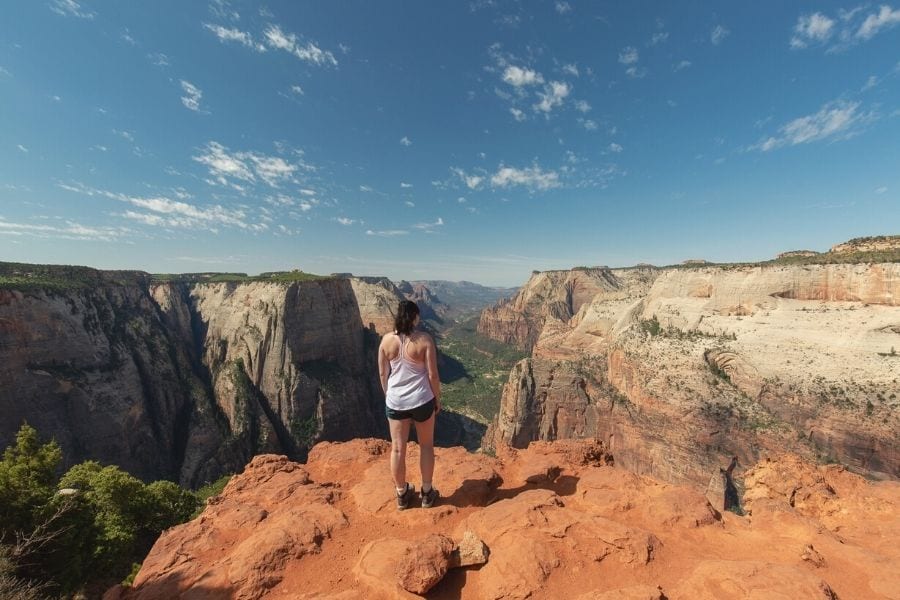

Best Time to Visit the Grand Canyon
The best time to visit Grand Canyon National Park is Spring or Fall. The weather is more pleasant during these months, and crowds are fewer than in the peak summer months. The best months to visit are April to mid-May or September.
The Grand Canyon South Rim is open year-round, while the North Rim is only open seasonally in the summer and fall.

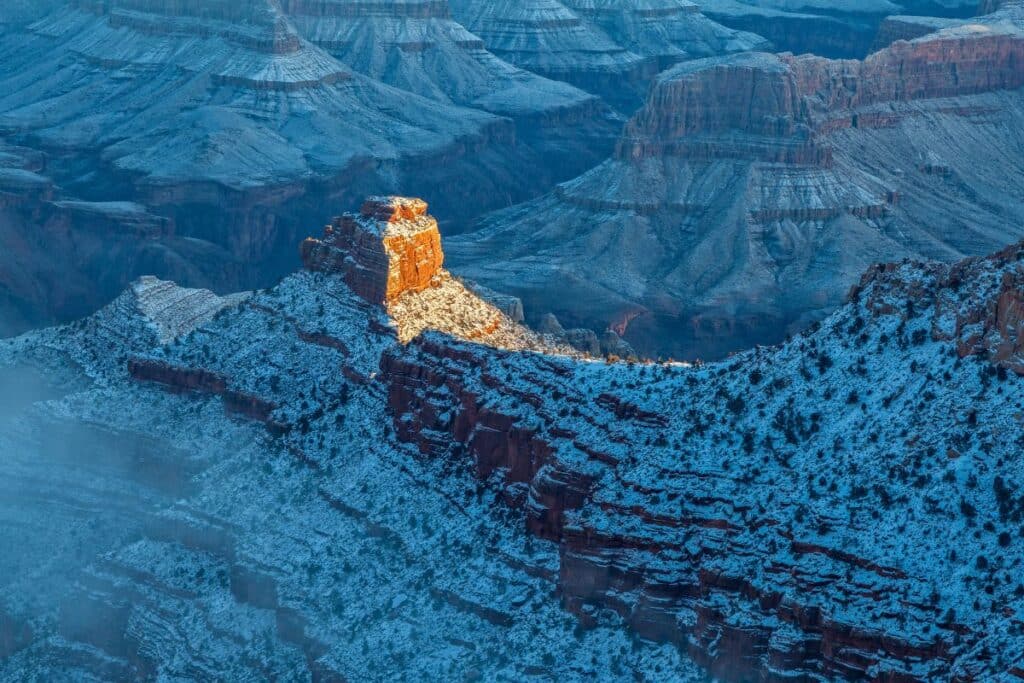
Here’s a breakdown of what to expect during each season at the Grand Canyon South Rim:
- Spring: Mid-to-late Spring is a pleasant time to visit, with mild temperatures and fewer crowds. Daytime temperatures typically average in the 60s during the spring at the south canyon rim, but nighttime temperatures are frequently below freezing. Hermit’s Rest Road closes to private vehicles on March 1, so springtime visitors should plan to take the free shuttle to those viewpoints.
- Summer: The busy season lasts from Memorial Day to Labor Day, with nearly 20,000 visitors to the park each day. In addition to the crowds, temperatures are HOT, coming in with daytime highs along the rim in the 80s and climbing to above 100 degrees in the canyon. Hiking this time of year can be dangerous due to the high temperatures and limited access to water. Hermit’s Rest Road is closed to private vehicles during the summer, so all visitors should plan to make use of the free shuttle instead.
- Fall: After Labor Day, crowds decrease, and temperatures drop too. Expect daytime temperatures in the 60s and 70s and overnight temperatures in the 30s or 40s. Fall is an excellent time of year for hiking in the Grand Canyon! Hermit’s Rest Road re-opens to private vehicles after November 30.
- Winter: Winter is the least busy time in the Grand Canyon, with cold, snowy weather for much of the season. Expect daytime temperatures in the 40s and overnight lows in the teens. However, there’s nothing more beautiful than exploring the snowy canyon with limited crowds!
Before planning your trip, check the park’s official website for the most up-to-date information on road and trail conditions, weather forecasts, and any closures or restrictions.
Where to Stay In and Near the Grand Canyon South Rim
Unlike many other national parks, Grand Canyon National Park’s South Rim has many places to stay, from luxury lodges to rustic motels to campgrounds. Staying inside the park minimizes your driving time and is ultra-convenient for taking the park shuttle from spring to fall.
However, staying outside the park in nearby towns like Tusayan, Grand Canyon Junction, or Williams offers more budget-friendly options.
This post covers where to stay at a high level, but check out this ultimate guide on the Best Places to Stay in Grand Canyon National Park for a deep dive!
This interactive map can help you search all the available hotels and rental properties near the Grand Canyon South Rim! Simply scroll and click the map below to see what is available.
There are six lodges located along the South Rim in Grand Canyon National Park:
- El Tovar Hotel is the oldest Grand Canyon National Park hotel steeped in history, operating since 1905. The hotel offers a fine dining room, gift shop, lounge, and luxurious lodge rooms.
- Bright Angel Lodge is a Registered National Historic Landmark with beautiful designs by Mary E.J. Colter. The hotel offers a mix of lodge rooms and rustic cabins along the Rim Trail, with several on-site restaurants and bars.
- Thunderbird Lodge sits along the Rim Trail overlooking the South Rim with updated hotel rooms and is within walking distance of many Grand Canyon Village viewpoints.
- Kachina Lodge is one of the more budget-friendly lodges directly along the South Rim, with three on-site restaurants only steps from the Rim Trail.
- Maswik Lodge is newly renovated and is one of the more budget-friendly options inside the park, with two onsite restaurants tucked away from the rim in a wooded area near the Grand Canyon Backcountry Information Center.
- Yavapai Lodge is another more budget-friendly option for staying in the park. This lodge is near the Grand Canyon Visitor Center and offers updated rooms and two onsite restaurants.
In addition, you’ll find three campgrounds at the South Rim:
- Mather Campground offers 327 reservable campsites and is open year-round. Amenities include flush toilets, fire pits, and drinking water.
- Trailer Village has campsites for RVs up to 50 feet long and is open year-round. Amenities include hookups, dump stations, drinking water, laundry, and shower facilities.
- Desert View Campground offers 49 reservable campsites near Desert View Watchtower and is open seasonally from April to October. Amenities include flush toilets, fire pits, and drinking water.

If you want to stay outside the park, opt for one of these hotels in nearby Tusayan. The National Park Service runs the Tusayan Purple Route shuttle throughout the town, directly into the park, connecting you to the rest of the park’s shuttles.
- The Grand Hotel is a 4-star hotel with an indoor pool, an on-site restaurant, and high-end hotel rooms. The shuttle picks up directly at the hotel before heading into the park.
- Best Western Squire Resort at the Grand Canyon is a pet-friendly 3.5-star hotel with two on-site restaurants, pools, an arcade, and bowling for a truly amenity-filled vacation. The shuttle picks up directly at the hotel. No need to walk to a shuttle stop!
- Red Feather Lodge is an updated 3-star hotel with an on-site restaurant, pool, and gym. Guests can walk across the street to Big E Steakhouse & Saloon to catch the shuttle into the park.
- Holiday Inn Express & Suites Grand Canyon is a popular chain 3-star hotel with reliable quality rooms, a pool, complimentary breakfast, and free WiFi. Guests can walk across the street to The Grand Hotel to catch the shuttle into the park.
- Grand Canyon Plaza Hotel is a pet-friendly 3-star hotel with an on-site restaurant, pool, and free WiFi. Guests can walk next door to the Grand Canyon IMAX Theater to catch the shuttle into the park.
For a unique stay, these two “glamping” options in Grand Canyon Junction provide a unique mix of luxury and outdoor adventure:
- Under Canvas Grand Canyon boasts 3-star accommodations in luxury canvas tents, including options for both shared and private bathrooms and an on-site restaurant.
- Clear Sky Resorts offers luxurious, air-conditioned futuristic domes with an on-site restaurant, bar, and many amenities.
Final Thoughts on the Best Things to Do at the Grand Canyon South Rim
There’s no shortage of incredible things to do in Grand Canyon National Park. If you’re short on time, I recommend prioritizing these top 10 activities:
- Visit the South Rim viewpoints
- Hike the Bright Angel Trail
- Hike the South Kaibab Trail
- Explore Hermit’s Rest Road
- Explore Desert View Drive
- Walk along the Rim Trail, including the Trail of Time section
- See the sunrise from Mather Point
- Visit the Yavapai Geology Museum
- Tour the Grand Canyon lodges
- Visit the Hopi House
Are you looking for more ideas for your trip to Grand Canyon National Park? Read these posts too!
- Itinerary: One Day at the Grand Canyon South Rim
- Viewpoints: 22 Best Views in Grand Canyon National Park
- Where to Stay: Best Places to Stay Near the Grand Canyon
- Nearby Parks: 19 Best National Parks Near Las Vegas
- Road Trip: Grand Canyon and Zion Road Trip Itinerary
Are you planning a national park trip but don’t know where to start? Get my free 28-page national park ebook where I break down everything you need to know to visit all 63 USA national parks.
Download your free ebook here.
Don’t Forget to Save This Post on Pinterest
